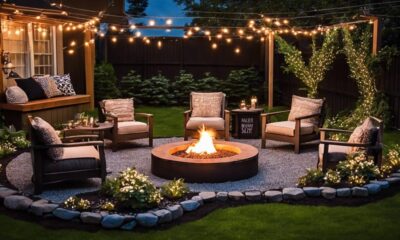Retreat
DIY Natural Cleaning Products for Your Home or Retreat Center
Create your own eco-friendly cleaning products that boost air quality and save money—discover simple recipes that will transform your cleaning routine!
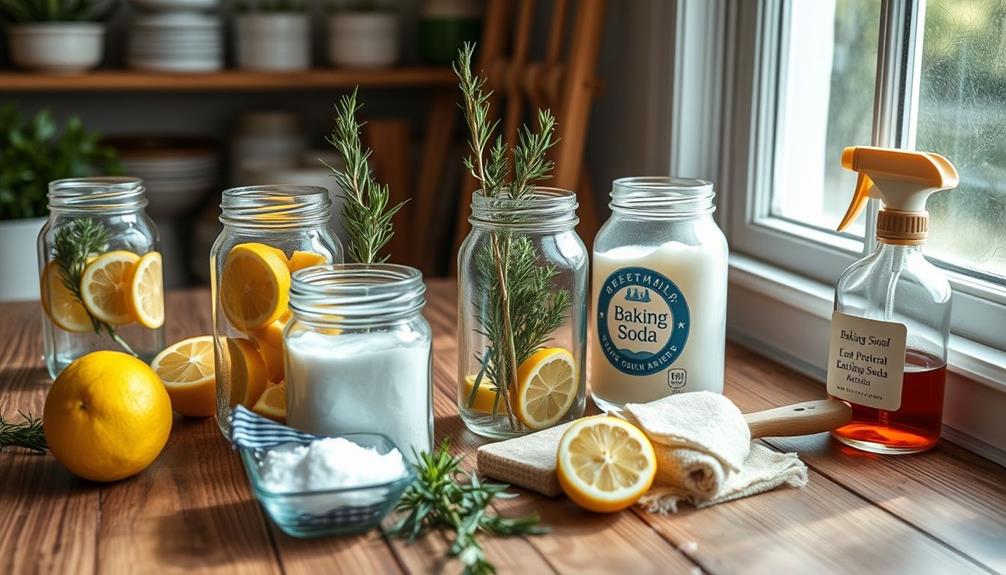
You can create DIY natural cleaning products for your home or retreat center using simple ingredients like vinegar, baking soda, and essential oils. These eco-friendly solutions eliminate harmful toxins, improve air quality, and save you money. For an all-purpose cleaner, mix half a cup of vinegar with two tablespoons of baking soda in a spray bottle. You'll find options for every area, from kitchens to bathrooms and laundry. Plus, you're doing your part for the environment by reducing plastic waste. If you want more recipes and tips for effective cleaning, there's much more to explore.
Key Takeaways
- Natural cleaners eliminate harmful toxins, improve air quality, and promote a healthier environment for homes and retreat centers.
- Essential ingredients like vinegar, baking soda, and castile soap create effective and eco-friendly cleaning solutions.
- Simple recipes, such as all-purpose cleaner and soft-scrub paste, make DIY cleaning easy and cost-effective.
- Fabric fresheners and carpet refreshers can be created using common pantry items for odor control and cleanliness.
- Storing homemade cleaners in glass containers ensures safety and longevity while avoiding chemical reactions.
Benefits of Natural Cleaners

When it comes to cleaning your home, opting for natural cleaners offers a range of benefits that go beyond just a tidy space. By using homemade cleaning solutions, you eliminate harmful toxins and chemicals commonly found in commercial products, improving your indoor air quality. This change reduces health risks associated with chemical exposure, making your home a safer place.
Additionally, many natural ingredients, like vinegar and baking soda, can be paired with used coffee grounds to create effective scrubs for tough stains, enhancing your cleaning routine through innovative coffee gear and accessories.
Natural cleaners, like vinegar and baking soda, are often more cost-effective than their commercial counterparts. You can save money over time by utilizing common pantry ingredients.
Plus, many of these natural ingredients possess antimicrobial properties, allowing you to disinfect surfaces effectively without compromising your health or the environment.
Choosing natural options also promotes sustainability. You reduce plastic waste from commercial products while minimizing harmful chemicals that can pollute waterways.
With customizable recipes, you can tailor your cleaning solutions to meet your specific needs and preferences, enhancing your overall cleaning experience. Whether you prefer the scent of certain essential oils or have sensitivities to specific ingredients, you can create a solution that works for you.
Embracing natural cleaners not only supports your health but also contributes to a healthier planet.
Kitchen Cleaning Recipes

When it comes to kitchen cleaning, you'll want to know the essential ingredients that can help you create effective solutions.
Utilizing natural products can't only enhance the cleanliness of your kitchen but also provide a healthier environment, similar to how coffee can enhance performance during workouts.
We've got some simple recipes that make tackling messes a breeze, plus tips for getting the most out of your homemade cleaners.
Let's get started on transforming your kitchen with natural products!
Essential Ingredients Overview
Understanding the essential ingredients for your DIY kitchen cleaning recipes can make a significant difference in your cleaning routine. By using natural cleaning products, you can create effective homemade cleaners that are both eco-friendly and safe for your family. Here are the key ingredients to examine:
| Ingredient | Benefits |
|---|---|
| Vinegar | Cuts through grease and neutralizes odors, making it a versatile all-purpose cleaner. |
| Baking Soda | Acts as a natural abrasive, removes stains and odors, especially when combined with vinegar. |
| Essential Oils | Adds natural disinfectant properties and pleasant fragrances for an enhanced cleaning experience. |
| Disinfectant Wipes | Soaked cloth squares provide quick and effective surface cleaning. |
Mixing 1/2 cup of vinegar, 2 tablespoons of baking soda, and a few drops of essential oils in a spray bottle creates a powerful all-purpose cleaner. For disinfectant wipes, soak cloth squares in a solution of 1 cup water, 1/4 cup vinegar, and essential oils. With these ingredients, you'll have the tools you need for effective and natural surface cleaning in your kitchen!
Effective Cleaner Recipes
Creating your own effective cleaning products can transform your kitchen into a sparkling, chemical-free space. Start with an all-purpose cleaner by mixing 1/2 cup of vinegar, 2 tablespoons of baking soda, and a few drops of your favorite essential oils in a spray bottle. This versatile solution tackles everyday cleaning with ease while also ensuring a healthier environment, akin to the benefits of using an air purifier for improved air quality.
For tougher messes, whip up a soft-scrub cleaner. Combine 1.5 cups of baking soda with 1/2 cup of liquid laundry soap and some essential oils to form a paste. This natural scrub will help you tackle grime without harsh chemicals.
If you're looking for a convenient way to sanitize surfaces, make disinfectant wipes by soaking cloth squares in a mix of 1 cup of water, 1/4 cup of vinegar, and essential oils. These eco-friendly wipes are perfect for quick clean-ups.
Don't forget about the dishes! Create a natural liquid dish soap by mixing 1/2 cup of distilled water, 1/2 cup of vinegar, and 1/2 cup of Dr. Bronner's Sal Suds.
For your homemade dishwasher detergent, blend 1 cup of salt, 2 cups of baking soda, 2 cups of Borax, and 1 cup of Lemi-Shine. Enjoy your clean kitchen!
Tips for Optimal Use
To get the most out of your DIY natural cleaning products, it's essential to use them correctly and efficiently.
Start with an all-purpose cleaner by mixing 1/2 cup of vinegar, 2 tablespoons of baking soda, and a few drops of essential oils, such as essential oils for respiratory health, in a spray bottle. Shake it well before each use to guarantee effectiveness.
For tough kitchen grime, create a soft-scrub cleaner using 1.5 cups of baking soda, 1/2 cup of liquid laundry soap, and essential oils to form a paste.
If you want quick disinfectant wipes, soak cloth squares in a solution of 1 cup water, 1/4 cup vinegar, and essential oils, and store them in a sealed container for easy access.
For a natural dish soap alternative, mix 1/2 cup distilled water, 1/2 cup vinegar, and 1/2 cup Dr. Bronner's Sal Suds.
Lastly, enhance your dishwasher's performance by combining 1 cup of salt, 2 cups of baking soda, 2 cups of Borax, and 1 cup of Lemi-Shine for a homemade detergent that tackles tough stains.
Following these cleaning tips will help you maximize the power of natural alternatives in your home.
Bathroom Cleaning Solutions

When it comes to keeping your bathroom fresh and clean, natural cleaning solutions can be both effective and simple to make. For a powerful toilet bowl cleaner, consider using Kool-Aid lemonade. Its citric acid properties work wonders to clean and deodorize, similar to how cold medications can provide effective relief.
For a streak-free shine on mirrors and glass, mix 1/4 cup vinegar, 1/4 cup rubbing alcohol, 1 tablespoon cornstarch, and 2 cups water.
If you prefer disinfectant wipes, soak cloth squares in a combination of 1 cup water, 1/4 cup vinegar, and your favorite essential oils. This makes for convenient cleaning of surfaces.
To tackle mildew, use a mildew cleaner made from vinegar, castile soap, and essential oils.
For a homemade all-purpose cleaner, try combining baking soda with vinegar; just remember not to mix them in closed containers to avoid overflow.
These natural cleaning solutions not only keep your bathroom sparkling but also help create a healthier environment. With these simple recipes, you can easily maintain a clean and inviting space without harsh chemicals.
Laundry Room Recipes
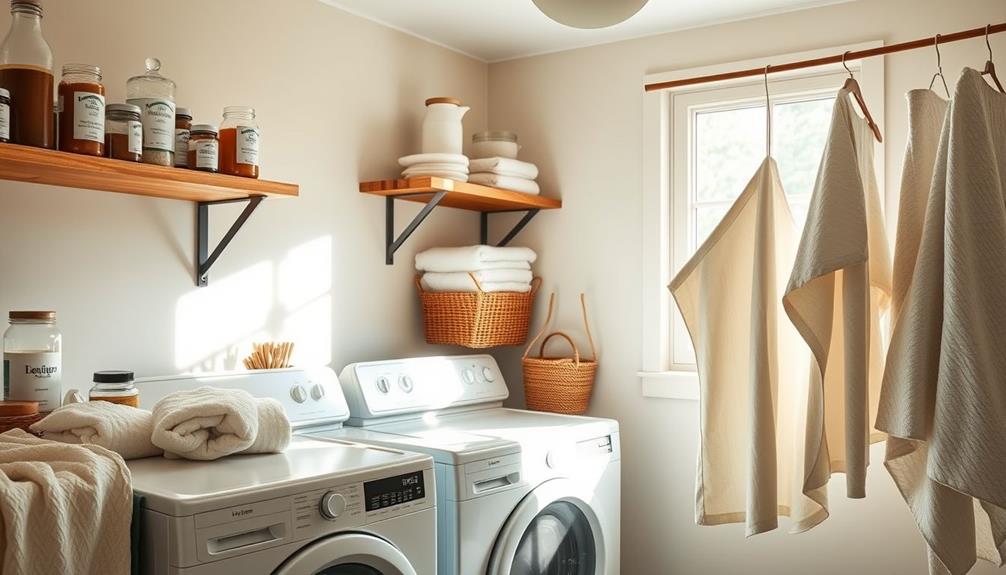
When it comes to laundry, you can easily create effective solutions for stain removal, eco-friendly detergents, and fabric fresheners right at home.
Incorporating essential oils for skin conditions can't only help with stains but also keep your fabrics smelling delightful.
With simple ingredients like vinegar, baking soda, and essential oils, you can tackle tough stains and keep your clothes smelling fresh.
Let's explore some easy recipes that will transform your laundry routine!
Effective Stain Removal Techniques
Effective stain removal techniques are essential for keeping your laundry looking fresh and clean. With a few DIY cleaning products, you can tackle tough stains without harsh chemicals.
Additionally, consider incorporating eco-friendly practices into your routine, such as using materials from sustainable sources, much like the innovative designs found in unique planter styles.
Here are some effective methods:
- Baking Soda Paste: Mix baking soda with water to create a paste. Apply it to the stain and let it sit for 30 minutes before rinsing.
- Vinegar and Baking Soda Combo: Combine 1 cup of vinegar with 1 cup of baking soda to fight stubborn odors and stains. Soak for 15-30 minutes before washing.
- Lemon Juice: For fresh stains on white fabrics, apply lemon juice directly to the stain and let it sun-bleach for a natural lift.
You can also use hydrogen peroxide for stains like wine or blood. Just apply it directly, let it sit for 5-10 minutes, and rinse.
For a gentle pre-treatment, mix 1/4 cup of liquid castile soap with 1 cup of water to create a stain remover.
With these natural cleaners, you'll keep your laundry looking great while using safe and effective cleaning recipes.
Eco-Friendly Laundry Detergent Recipes
Creating your own eco-friendly laundry detergent not only saves money but also reduces your impact on the environment, allowing you to engage in innovative problem-solving processes while taking care of your home.
With simple ingredients, you can whip up effective homemade solutions that keep your clothes fresh and clean.
For a basic homemade liquid laundry detergent, mix 1/2 cup Borax, 1/2 cup washing soda, and 1/2 cup Dawn dish soap in 4 cups of hot water. This eco-friendly blend is powerful and cost-efficient.
If you prefer a natural alternative, try soap nuts, which contain saponin and are biodegradable. You can reuse them multiple times before composting.
To brighten whites without harsh chemicals, create a natural bleach alternative by combining 1 gallon of hot water with 1 tablespoon of castile soap and 2 tablespoons of hydrogen peroxide.
For a softener, simply add 1 cup of vinegar during the rinse cycle. This natural softener not only helps eliminate static cling but also softens your clothes, avoiding synthetic additives.
With these recipes, you'll enjoy effective at cleaning your laundry while being kind to the environment. Embrace these natural solutions and transform your laundry routine today!
Fabric Freshening Solutions
A few simple ingredients can transform your laundry routine with homemade fabric freshening solutions that effectively eliminate odors and leave your fabrics smelling great.
These natural cleaning recipes not only freshen up your items but also promote healthier living by avoiding harsh chemicals. Implementing these methods can be likened to the importance of quality assurance in software development, as both guarantee high standards and user satisfaction ensures software meets high-quality standards.
To create a basic fabric freshener, mix equal parts of distilled water and white vinegar in a spray bottle, adding 10-20 drops of your favorite essential oil. This combination works wonders for absorbing odors.
You can also enhance your freshener by including baking soda, which is particularly effective for upholstery and carpets.
Here are a few more ideas for fabric fresheners:
- Odor Neutralizer: Combine 1 cup of water, 1 tablespoon of vodka, and 10 drops of essential oil.
- Scent Booster: Mix 1 cup of Epsom salt with 10-15 drops of essential oil and let it sit for a day before adding it to your wash.
- Carpet Refresher: Create a baking soda mixture with essential oils to sprinkle on carpets before vacuuming.
With these homemade solutions, you'll enjoy fresher fabrics without compromising your health!
Living Area Cleaners
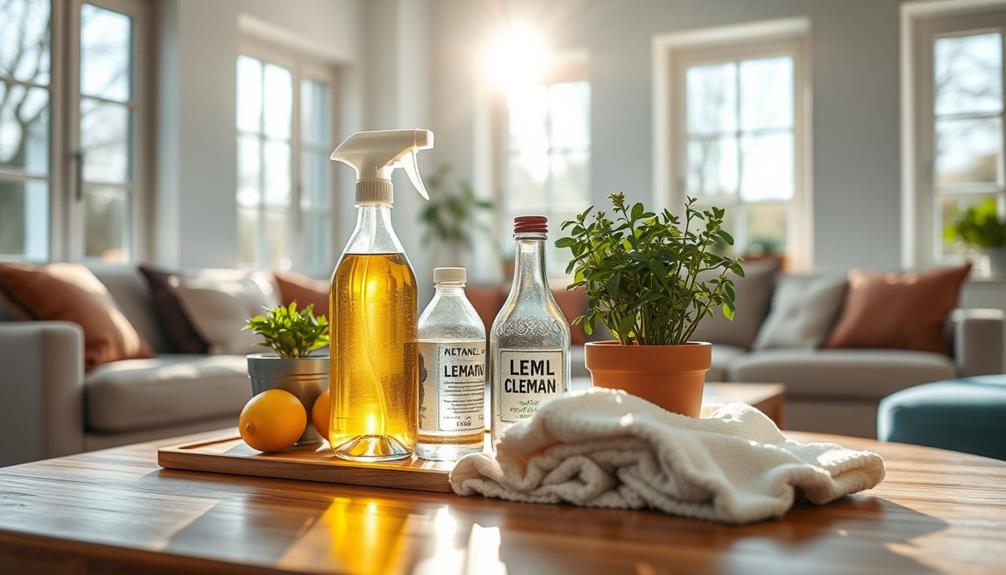
Keeping your living area fresh and clean doesn't have to involve harsh chemicals. You can create your own natural cleaners that effectively tackle dirt and odors. One great option is a dusting spray made from 1 tablespoon of castile soap, 15 drops of lemon essential oil, and 2 cups of water in a spray bottle. This cleaner not only cleans surfaces but also leaves a revitalizing scent.
Additionally, maintaining a clean environment can contribute to your overall financial health by reducing the need for costly commercial cleaning products, making it a wise financial choice.
For polishing wooden furniture, mix 3/4 cup of olive oil with 1/4 cup of white vinegar, adding 30 drops of essential oil if you like. This wood polishing spray nourishes and protects without harmful chemicals.
If your carpets need a renewal, try a carpet freshener made from 2 cups of Borax, 1 cup of baking soda, and 10 drops of essential oil. Sprinkle it on before vacuuming to absorb odors.
For tough stains, start with baking soda and follow up with a mixture of Dawn dish soap, vinegar, and warm water to lift those pesky marks.
Incorporating essential oils into your living area cleaners not only enhances the scent but also adds antibacterial properties, making your home a healthier space.
Essential Ingredients for Cleaners
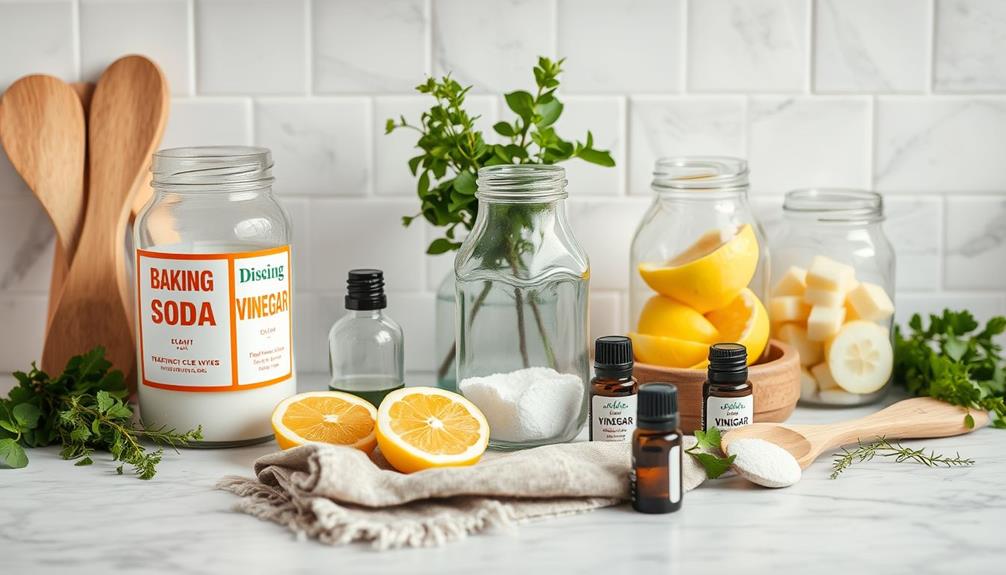
What essential ingredients can elevate your natural cleaning routine? Incorporating a few key elements can transform your DIY cleaners into powerful, effective solutions. Here are three essential ingredients to take into account:
- Vinegar: This versatile natural disinfectant cuts through grease, removes hard water stains, and deodorizes surfaces without the use of harmful chemicals.
- Baking Soda: A mild abrasive, baking soda absorbs odors and removes stains. When combined with vinegar, it creates a potent cleaning spray for tougher messes.
- Castile Soap: This biodegradable, plant-based soap is safe for use around children and pets. Dilute it for various cleaning tasks, making it a fantastic choice for general cleaning purposes.
Don't forget to enhance your cleaners with essential oils like tea tree, lavender, or lemon. These oils not only add pleasant fragrances but also offer antibacterial and antifungal properties, boosting your cleaner's effectiveness.
Together, these ingredients create powerful, eco-friendly solutions to keep your home sparkling clean while being kind to the environment. With these essentials, you're well on your way to mastering DIY cleaning products!
Tips for Homemade Cleaners
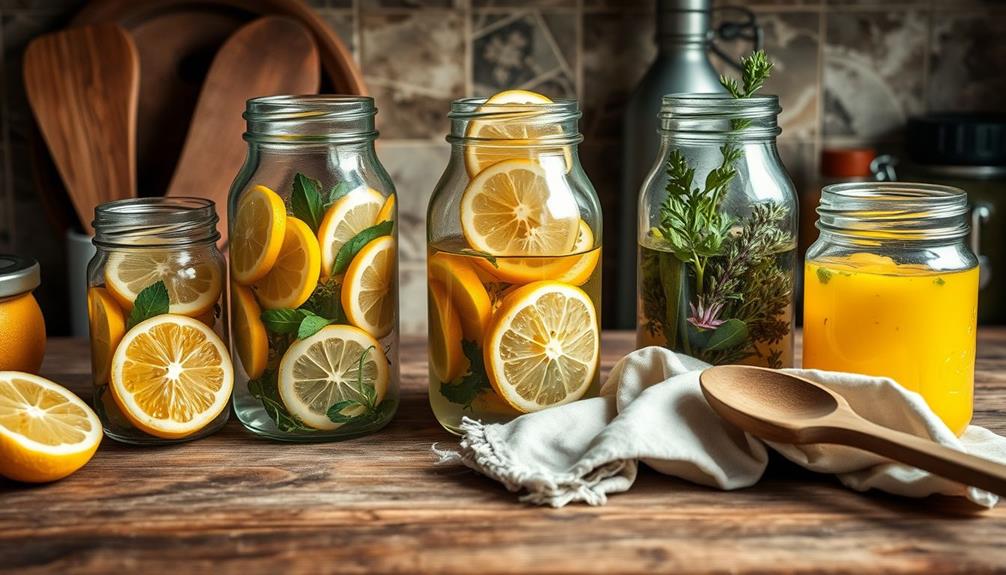
When you're making homemade cleaners, safe storage is just as important as using the right ingredients.
Experimenting with different combinations can lead to effective new solutions, but always test them on small areas first.
Safe Storage Practices
Storing homemade cleaners safely is essential for maintaining their effectiveness and guaranteeing your family's safety. Using the right storage practices can help you avoid accidents and keep your cleaning products potent.
Here are some tips to follow:
- Use glass containers: Glass or recycled containers are best for storing homemade cleaners. They prevent chemical reactions and don't leach harmful substances, unlike plastic.
- Label cleaning products: Clearly label all your homemade cleaners with their contents and the date of preparation. This helps you avoid confusion and guarantees proper usage.
- Keep out of reach: Always store cleaning solutions out of reach of children and pets to prevent accidental ingestion or contact with potentially harmful ingredients.
For powders like baking soda, use airtight containers to prevent moisture absorption, which can lead to clumping and reduced effectiveness.
Regularly check the potency of your homemade cleaners, especially those containing vinegar and essential oils, as they can lose their effectiveness over time.
Ingredient Experimentation Tips
Keeping your homemade cleaners effective goes hand in hand with experimenting with different ingredients. Start by adjusting the ratios of vinegar and water to find the ideal cleaning strength for various surfaces. Vinegar solutions can be tailored to your specific cleaning tasks, making them versatile and efficient.
When using baking soda, remember that it can clog spray bottles. Instead, consider using it in a paste form or mix it with water before application for a smoother experience. Essential oils can elevate your natural cleaning products not only by adding fragrance but also by providing antibacterial properties. Just be cautious about the types of oils you choose, especially if you have pets.
Always test your homemade cleaners on small, inconspicuous areas before applying them widely. This helps you avoid damaging any surfaces or fabrics.
Regularly experiment with ingredients like hydrogen peroxide, castile soap, and lemon juice to discover more effective cleaning solutions tailored to your preferences. By mixing and matching these components, you'll create a lineup of homemade cleaners that work best for your home or retreat center. Happy experimenting!
Environmental Impact and Awareness
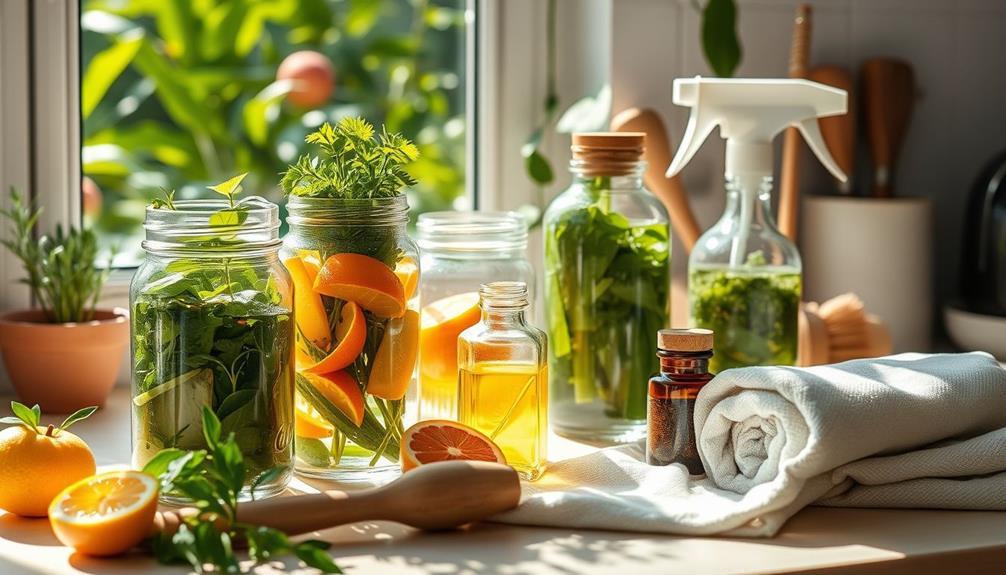
The choice to use DIY natural cleaning products plays an essential role in fostering environmental awareness and reducing our ecological footprint. When you opt for homemade cleaners, you greatly lower household toxins and chemicals, which contributes to improved indoor air quality and a healthier living environment.
By using natural ingredients like vinegar, baking soda, and essential oils, you also tackle plastic waste, minimizing the need for single-use commercial cleaning product packaging.
Consider these benefits of switching to eco-friendly cleaners:
- Biodegradable: They break down quickly, reducing pollution in waterways.
- Healthier choices: Using natural ingredients promotes sustainable living, benefiting both your health and the environment.
- Cost-effective: DIY cleaning solutions save you money while giving you control over what you use.
Community Engagement in Cleaning
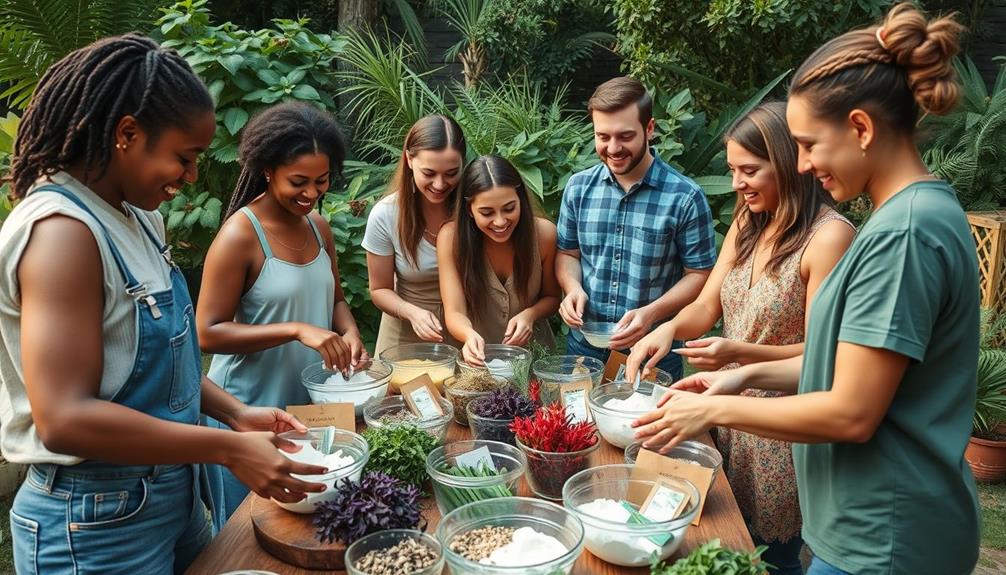
Community involvement in natural cleaning practices creates a vibrant exchange of ideas and experiences. When you engage with others in a community setting, you'll find that recipe sharing becomes a cornerstone of collaborative learning. This supportive environment enhances your understanding of homemade products and eco-friendly cleaning methods.
As you discuss your experiences with DIY cleaners, you'll uncover common challenges that many face. This opens the door for collective problem-solving, leading to improved cleaning methods and natural scouring techniques.
You'll appreciate the emphasis on ingredient transparency, as community members advocate for awareness of the health and environmental impacts of the products you choose to use.
Ingredient substitutions and customization are frequently explored, allowing you to adapt recipes to suit your specific needs. This fosters creativity in your cleaning solutions, making the process not only effective but also enjoyable.
Experimenting With Recipes
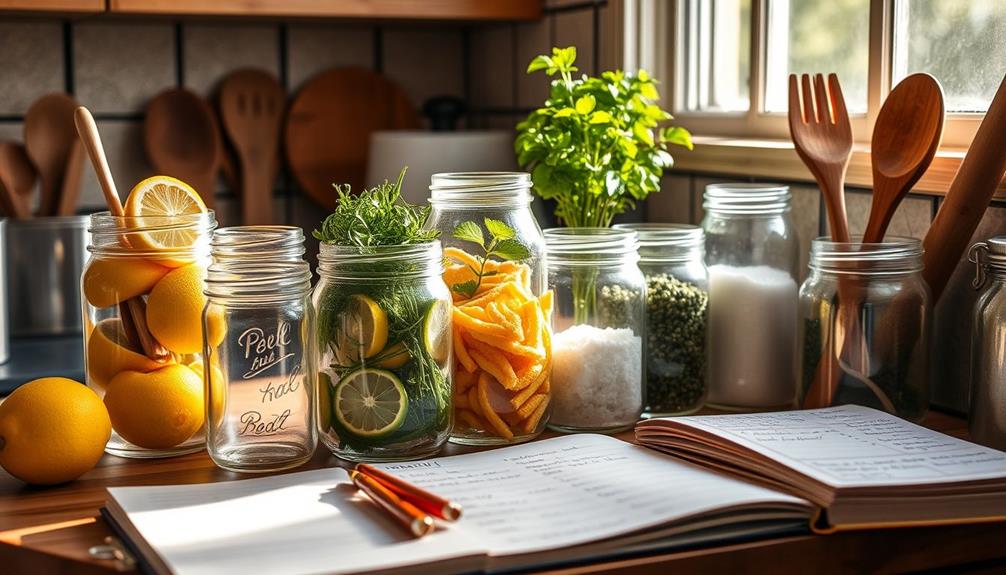
Building on the shared knowledge from community discussions, experimenting with different DIY cleaning recipes can lead to effective and personalized solutions for your home. By adjusting ratios of vinegar, baking soda, and essential oils, you'll discover the most effective homemade cleaner tailored to your specific needs.
Here are a few tips to enhance your natural cleaning journey:
- Start with small batches to minimize waste and easily adjust based on cleaning efficacy.
- Use a simple vinegar and water solution for general cleaning, as it often outperforms baking soda and vinegar mixtures.
- Customize your recipes—try adding tea tree oil for its antifungal properties when tackling mold and mildew.
Documenting the results of each experiment is vital. It helps you identify what combinations work best for different tasks, refining your natural cleaning arsenal over time.
Frequently Asked Questions
How Do You Make Holistic Cleaning Products?
To make holistic cleaning products, you can mix equal parts water and vinegar for an all-purpose cleaner. Enhance it with essential oils. Experiment with combinations to find what works best for your needs and preferences.
How to Make Homemade Multi-Purpose Cleaner?
You'd think making a multi-purpose cleaner is complicated, but it's not! Just mix equal parts water and vinegar, add essential oils, and a teaspoon of castile soap. Shake, spray, and watch dirt disappear!
What Is the Best Natural Thing to Clean With?
The best natural cleaner is vinegar. It effectively kills germs and deodorizes surfaces. Combine it with baking soda for tough stains, or use lemon juice for grease. These options are safe, eco-friendly, and versatile for your needs.
How Can I Deep Clean My House Naturally?
When it comes to deep cleaning your house naturally, think of it as a revitalizing spring rain washing away the grime. Mix vinegar and water, or use baking soda paste for stubborn stains. Enjoy the transformation!
Conclusion
By embracing DIY natural cleaning products, you're not just sprucing up your home; you're transforming it into a fragrant oasis, where every surface sparkles like the sun on a summer's day! Imagine a kitchen that smells like a citrus grove and a living room infused with the freshness of wildflowers. You're not just cleaning; you're creating a sanctuary of health and happiness. So grab those ingredients, release your inner cleaning wizard, and watch your home bloom into a purifying paradise!
- About the Author
- Latest Posts
Introducing Ron, the home decor aficionado at ByRetreat, whose passion for creating beautiful and inviting spaces is at the heart of his work. With his deep knowledge of home decor and his innate sense of style, Ron brings a wealth of expertise and a keen eye for detail to the ByRetreat team.
Ron’s love for home decor goes beyond aesthetics; he understands that our surroundings play a significant role in our overall well-being and productivity. With this in mind, Ron is dedicated to transforming remote workspaces into havens of comfort, functionality, and beauty.
Retreat
10 Unique Themed Room Ideas for Your Retreat Center
Navigate through ten unique themed room ideas for your retreat center that promise to inspire and rejuvenate your guests in unexpected ways.

You can transform your retreat center with ten unique themed room ideas that cater to a variety of experiences. Create a Nature-Inspired Sanctuary using natural materials and large windows for serene views, or design a Cozy Reading Nook filled with oversized chairs and light-filled spaces. A Tranquil Spa Retreat fosters relaxation with soothing colors, while an Artistic Creative Space encourages self-expression. Consider a Rustic Cabin Escape for warmth and connection to nature, or a Vibrant Wellness Studio to energize guests. There's also a Coastal Beach Haven and more whimsical options like a Children's Room. Explore all ten ideas to inspire your space!
Key Takeaways
- Create a Nature-Inspired Sanctuary using reclaimed wood, stone, and indoor plants to foster a calming atmosphere and connection to the outdoors.
- Design a Tranquil Spa Retreat with soothing color palettes, bamboo elements, and essential oil diffusers to promote relaxation and rejuvenation.
- Establish a Serene Meditation Room featuring soft lighting, comfortable seating, and natural elements to enhance mindfulness and peace.
- Develop an Artistic Creative Space with multifunctional furniture and vibrant decor to inspire imagination and self-expression through various artistic pursuits.
- Incorporate a Vibrant Wellness Studio with energizing colors, ample natural light, and flexible furniture arrangements to support positivity and community during classes.
Nature-Inspired Sanctuary

Creating a nature-inspired sanctuary at your retreat center can transform the space into a peaceful haven. To achieve this, start by incorporating natural materials like reclaimed wood and stone, which foster harmony with the environment.
Consider adding features like a DIY fire pit that enhances outdoor spaces, allowing guests to connect with nature while enjoying warmth and ambiance. Choose organic textiles that not only feel good but also connect your decor to nature.
Maximize natural light with large windows or glass doors, allowing unobstructed views of the outdoor landscape. This seamless connection blurs the lines between indoor comfort and outdoor beauty.
Add indoor plants like snake plants and peace lilies; they purify air and enhance the calming atmosphere.
For relaxation, consider integrating a natural water feature such as a small fountain or pond. The soothing sounds of flowing water promote mindfulness and tranquility.
Use a calming color palette inspired by nature—think earthy greens, browns, and soft blues—to evoke a serene retreat experience.
Complete the look with a rustic coffee table made of reclaimed wood, providing a natural gathering spot for guests to share stories or enjoy a warm beverage.
This sanctuary won't only beckon relaxation but also create lasting memories for all who visit.
Cozy Reading Nook

Creating a cozy reading nook starts with choosing comfortable seating that invites you to sink in and unwind.
Soft lighting, whether from a nearby window or a stylish lamp, sets the perfect mood for getting lost in a good book.
To enhance the experience, consider incorporating soothing scents from essential oils, such as lavender oil, which can promote relaxation and focus essential oils for relaxation.
Additionally, include nature-inspired decor elements, like plants or earthy colors, that bring a sense of tranquility to your retreat center.
Comfortable Seating Options
When designing a cozy reading nook, you'll want to focus on comfortable seating options that invite you to unwind and lose track of time. Consider oversized armchairs or plush bean bags that envelop you in comfort, making it easy to settle in for hours with a good book.
Incorporating natural materials, such as wood accents or stone elements, can enhance the rustic feel of your nook and create a harmonious space that aligns with modern farmhouse decor trends. These seating choices not only provide support but also encourage a relaxed posture.
To elevate the coziness, incorporate soft textiles like throw blankets and decorative pillows. They add warmth and a touch of style, making your nook feel like a personal retreat.
Positioning this space near a window is key; natural light enhances the reading experience and creates a tranquil atmosphere.
Don't forget about functionality! Install bookshelves or wall-mounted storage nearby to keep your reading materials organized and within arm's reach. This way, you won't have to interrupt your reading flow.
Soft Lighting Ambiance
A warm ambiance is essential for transforming your reading nook into a true sanctuary. Soft lighting enhances relaxation and encourages a tranquil atmosphere that invites you to immerse yourself in your favorite book.
To achieve this cozy feel, consider the following:
1. Use warm-toned LED bulbs: These create a gentle glow that's perfect for winding down in the evenings. Dimmable fixtures can adjust brightness throughout the day, setting the ideal mood whenever you need it.
Additionally, energy-efficient lighting solutions can help reduce overall power consumption, allowing you to enjoy your nook guilt-free while being mindful of electricity usage energy-efficient appliances.
2. Incorporate layered lighting: Mix table lamps, floor lamps, and wall sconces to provide both ambient and task lighting. This guarantees you have enough light for reading without feeling overwhelmed by harsh brightness.
3. Add whimsical touches: String lights or fairy lights can spark joy and complement your reading nook's cozy atmosphere. They offer soft, twinkling illumination that enhances relaxation without dominating the space.
Don't forget light-filtering curtains or shades, which allow natural light during the day while maintaining a soft glow in the evenings.
With these elements in place, your reading nook will become a perfect escape for reflection and relaxation.
Nature-Inspired Decor Elements
Transforming your cozy reading nook into a nature-inspired retreat can elevate your relaxation experience. Start by incorporating natural materials like wood and stone to create an inviting atmosphere that mirrors the beauty of the outdoors. Soft textiles such as organic cotton or linen for cushions and throws enhance comfort while staying eco-friendly.
Position your reading nook near windows to maximize natural light, forging a serene connection to the outside world. This brightens your space and uplifts your mood. Adding indoor plants like ferns or snake plants not only purifies the air but also introduces a revitalizing touch of greenery, promoting tranquility.
To complete your nature-inspired haven, consider incorporating nature-themed artwork or photographs that evoke a sense of peace. This visual element helps create a soothing environment, perfect for unwinding with a good book.
| Decor Element | Purpose |
|---|---|
| Natural materials | Create warmth and invite nature |
| Soft textiles | Enhance comfort and eco-friendliness |
| Natural light | Connect with the outdoors |
| Indoor plants | Purify air and add greenery |
| Nature-inspired art | Evoke tranquility |
Tranquil Spa Retreat

Creating a tranquil spa retreat starts with a soothing color palette, using soft blues and greens to set a calming tone.
Incorporating nature-inspired design elements like bamboo and stone helps you connect with the outdoors, enhancing the serene atmosphere.
Additionally, consider adding essential oils for relaxation, as certain scents can greatly contribute to a peaceful environment; for instance, essential oils for relaxation can be diffused or used in massage oils.
Together, these choices promote relaxation and healing for anyone who enters the space.
Soothing Color Palette
How can you design a soothing color palette that promotes tranquility in your spa retreat? Start by focusing on soft shades of blue and green, as these colors are known to lower heart rates and reduce stress. Incorporating neutral tones can further enhance relaxation, grounding your decor while creating a natural ambiance.
Additionally, creating a serene environment can be complemented by guaranteeing peak comfort through the use of energy-efficient models that regulate temperature effectively, enhancing the overall experience.
To help you choose the perfect palette, consider these three key elements:
- Pastel Hues: Light blues, greens, and pinks evoke a sense of serenity, making them ideal for creating a calming atmosphere.
- Muted Earth Tones: Colors like soft taupe, beige, and gentle browns ground your retreat, ensuring the environment feels warm and inviting.
- Accent Colors: Introduce subtle touches of soft lavender or gentle peach. These hues can enhance feelings of calmness and joy, enriching the overall healing experience.
Layering different shades within your palette adds depth and interest, creating a cohesive look. This thoughtful approach guarantees that your spa retreat becomes a serene sanctuary, inviting guests to unwind and rejuvenate amidst a tranquil backdrop.
Nature-Inspired Design Elements
Embracing nature-inspired design elements can elevate your tranquil spa retreat, seamlessly blending indoor and outdoor spaces. Start by incorporating natural materials like bamboo, stone, and reclaimed wood, which create a soothing, earthy atmosphere that reflects the surrounding environment. This connection to nature promotes relaxation and enhances the overall experience for your guests.
Additionally, consider the benefits of a calming environment on physical health, as cold medications overview can be less effective in stressful settings.
Next, utilize a calming color palette of soft greens, blues, and neutrals. These hues evoke peace and tranquility, reminiscent of serene landscapes. To further enhance the ambiance, integrate water features like indoor fountains or aquariums. The soothing sounds of water not only promote serenity but also create a revitalizing atmosphere.
Maximize natural light by installing large windows or glass walls, allowing unobstructed views of the outdoors. This design choice strengthens the connection between the interior and the natural world while infusing the space with warmth.
Artistic Creative Space
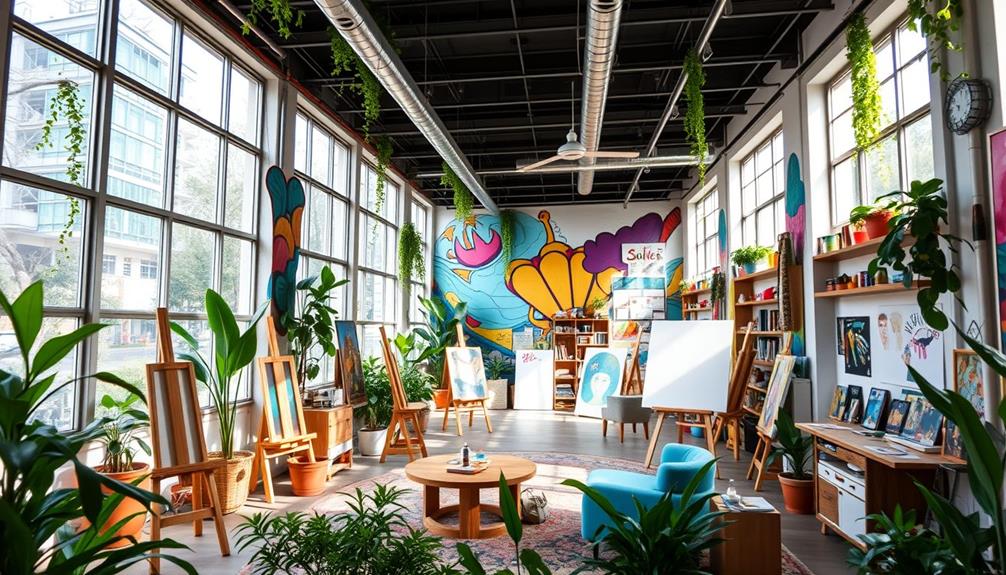
Inspiration flourishes in an artistic creative space designed to ignite your guests' imagination and self-expression. By incorporating vibrant colors and inspiring decor, you create an environment that stimulates creativity.
Research shows that curiosity fosters social connections and enhances creativity, making it essential to cultivate a space that encourages exploration. Large windows or skylights let in natural light, enhancing the ambiance and connecting guests with the outdoors, fostering a peaceful atmosphere for artistic pursuits.
To maximize functionality, consider these essential features for your artistic creative space:
- Multifunctional Furniture: Use easels that double as display boards and collapsible tables to create versatile workspaces. This flexibility encourages guests to adapt the space to their needs.
- Diverse Artistic Tools: Provide a variety of materials including paints, clay, and textiles. This assortment allows guests to experiment and explore different mediums, fostering creativity without limits.
- Designated Activity Areas: Create spaces for specific activities, like a quiet corner for writing, a painting station, and a crafting zone. This setup lets guests choose their preferred mode of expression, enhancing their overall experience.
Rustic Cabin Escape
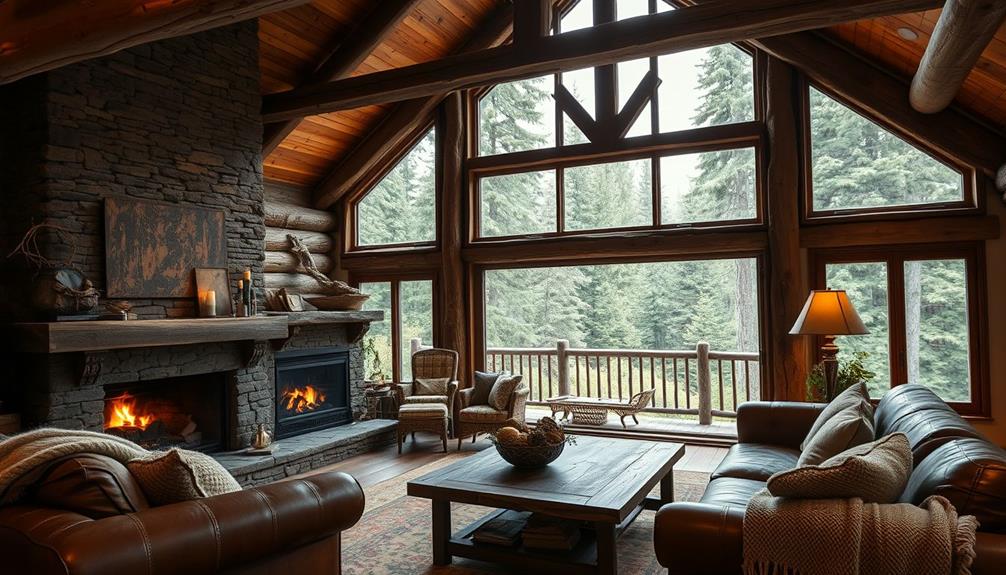
After spending time in an artistic creative space, you might find that a rustic cabin escape offers a different kind of inspiration—one rooted in simplicity and nature. Imagine stepping into a cabin with exposed wooden beams and a stone fireplace, instantly feeling the warmth and comfort of reclaimed wood and vintage furniture. This setup not only enhances the charm but also provides authenticity and character.
Natural light plays an essential role in a rustic cabin. Large windows frame breathtaking views of the outdoors while flooding the interior with sunlight. To boost the cozy atmosphere, incorporate textiles like wool blankets and burlap accents, making the space inviting and homely.
Consider these elements to create your rustic cabin escape:
| Element | Description |
|---|---|
| Natural Materials | Use reclaimed wood for authenticity |
| Vintage Furniture | Add handmade pieces for character |
| Earthy Color Palette | Incorporate deep greens, browns, and grays |
| Cozy Textiles | Use wool blankets for warmth and comfort |
This combination fosters tranquility, making your cabin the perfect retreat for relaxation and reflection.
Serene Meditation Room
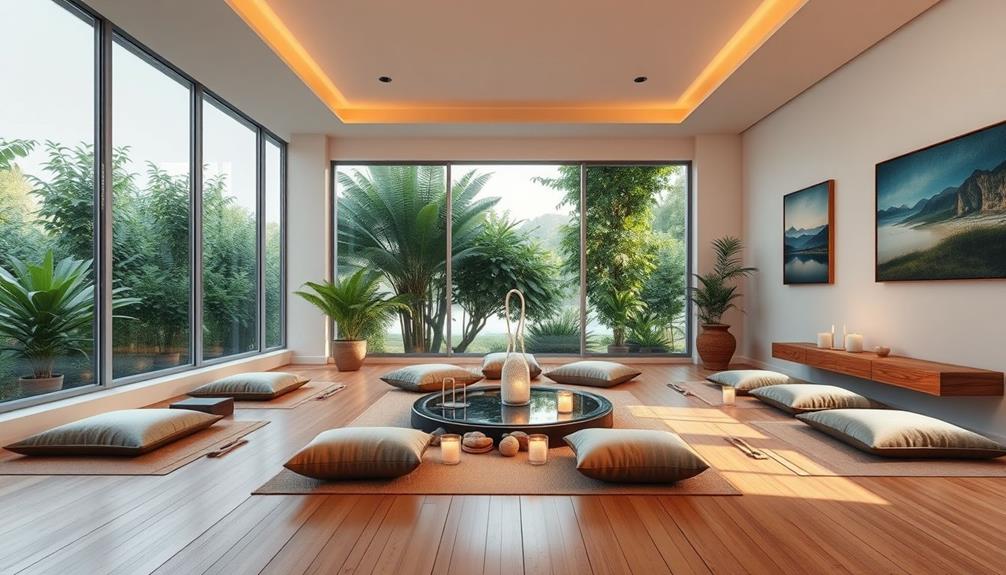
Creating a serene meditation room transforms your space into a sanctuary for mindfulness and relaxation. To achieve this calming atmosphere, focus on three key elements that enhance your meditation experience:
- Soft Lighting: Incorporate dimmable lamps and candles to create a gentle glow. This soft lighting helps reduce distractions and invites tranquility, similar to the calming effects of music therapy integration.
- Soothing Color Palette: Choose colors like soft blues, greens, and neutrals. These hues promote peace within the space, making it easier for you to unwind and connect with your inner self.
- Comfortable Seating: Use meditation cushions or bean bags to provide inviting seating options. Comfort is essential for prolonged meditation sessions, allowing you to fully immerse yourself in the practice.
Additionally, consider integrating natural elements like indoor plants and water features to purify the air and add soothing sounds.
Personal touches, such as meaningful artwork or inspirational quotes, can strengthen your emotional connection to the space.
Vibrant Wellness Studio
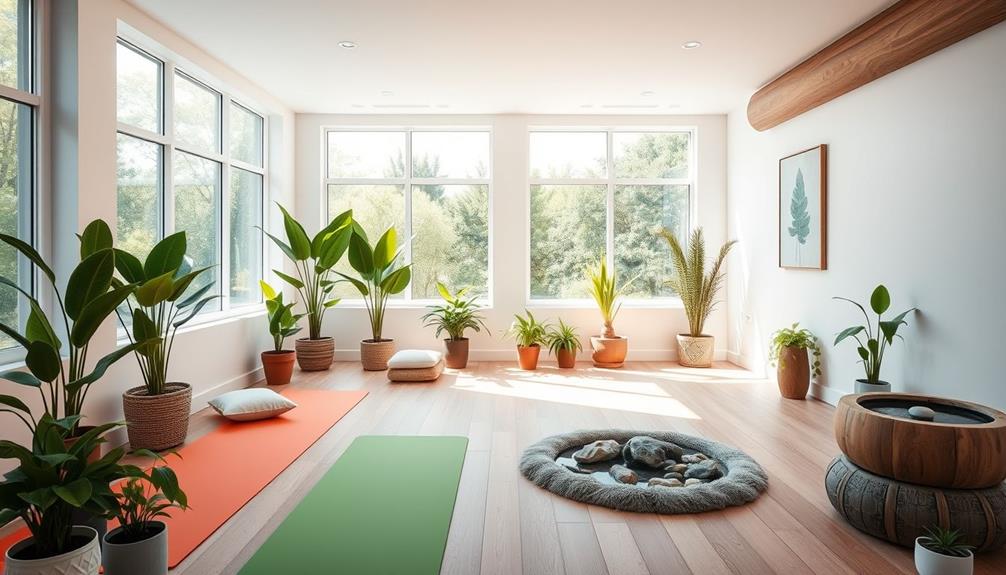
A vibrant wellness studio energizes your retreat center, fostering a space where participants can engage in uplifting activities that promote physical and mental well-being.
To create this atmosphere, choose a bright and energizing color palette, like yellows and greens, which can enhance positivity and liveliness during classes. Incorporating elements such as music can elevate the experience; for instance, consider using tracks that evoke feelings of joy and nostalgia, similar to Blue Skies and Lemonade by Rhythm Failure.
Large windows or skylights are essential; they let in natural light, making the studio inviting and supportive of mental wellness.
Incorporate natural materials, such as bamboo flooring and organic cotton textiles, to deepen the connection to nature. This grounding environment is perfect for relaxation and mindfulness practices. You can also integrate essential oil diffusers to fill the space with soothing scents, which have been shown to reduce stress and improve focus during yoga or meditation sessions.
Flexible furniture arrangements, including movable mats and cushions, allow for varied class formats and group sizes. This adaptability not only accommodates different activities but also promotes a sense of community among participants.
With these elements, your vibrant wellness studio will become a cherished part of your retreat center, encouraging everyone to engage fully in their wellness journey.
Coastal Beach Haven
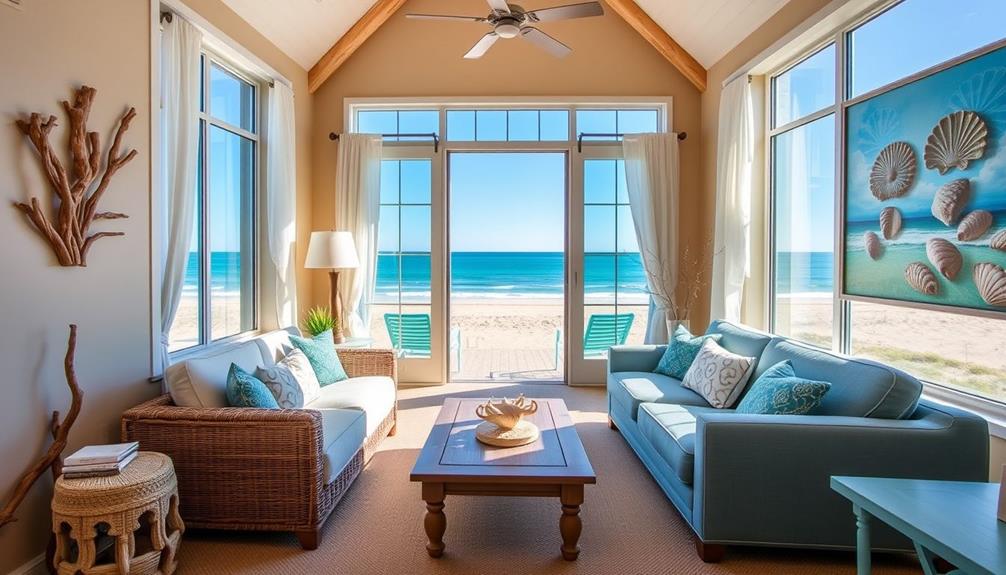
Embrace the tranquility of a coastal beach haven, where soft blues and sandy neutrals come together to evoke the serene beauty of the ocean.
This theme invites you to create a space that feels like a relaxing getaway, perfect for rejuvenation and reflection. Start by incorporating natural materials like driftwood and rattan furniture, which add texture and warmth to the atmosphere.
To enhance your coastal retreat, consider these three key elements:
- Nautical Decor: Use lanterns, marine-inspired artwork, and woven textiles to establish a relaxed, beachy vibe.
- Natural Light: Opt for large windows or light fabrics that encourage natural light to flood the room, mimicking the openness of the beach.
- Focal Points: Add unique features like a seashell chandelier or a woven raffia coffee table to reinforce the coastal theme while serving functional purposes.
Whimsical Children's Room
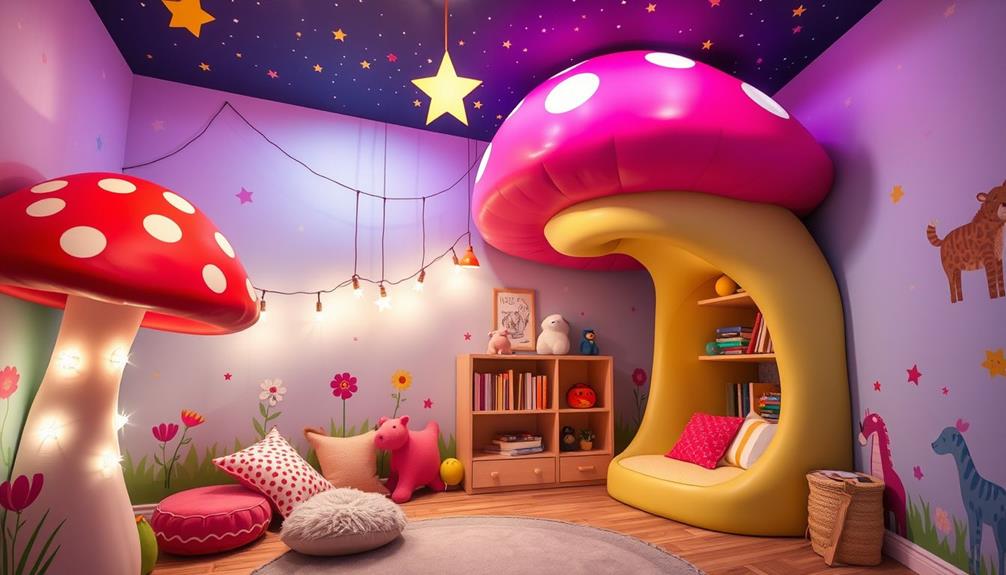
Creating a whimsical children's room means embracing enchanting color palettes that spark joy and imagination.
You'll want to choose playful furniture that not only looks fun but also serves a purpose, like beds with slides or quirky storage options.
Don't forget to add interactive decor elements, such as chalkboard walls, to keep their creativity flowing and make the space truly engaging.
Enchanting Color Palettes
Transforming a children's room into a whimsical retreat involves selecting enchanting color palettes that spark imagination and joy. To create an inviting atmosphere, consider using soft pastels combined with vibrant primary colors and playful accents. These hues not only brighten the space but also inspire creativity.
Here are three essential elements to incorporate in your color scheme:
- Nature-Inspired Tones: Incorporate mint greens, sky blues, and sunny yellows to evoke a sense of wonder. These colors can transform the room into a mini oasis, where children feel connected to the outdoors.
- Mood-Enhancing Colors: Utilize warm hues like coral and peach to energize the space, while cooler shades like lavender and aqua encourage calmness. This balance can help foster a dynamic yet tranquil environment for play and relaxation.
- Dynamic Patterns and Textures: Combine playful patterns like polka dots, stripes, and florals to enhance visual interest. This not only makes the room more engaging but also supports exploration and imaginative play.
Playful Furniture Choices
Furniture plays an essential role in bringing a whimsical children's room to life. To spark creativity, consider incorporating furniture pieces that double as play elements, like a bed shaped like a pirate ship or a tent-style play area. These imaginative designs invite adventure and storytelling, making the space truly magical.
Choose vibrant, bold colors for your furniture, such as bright yellow chairs or a rainbow-colored bookshelf. This creates a joyful atmosphere that energizes children and keeps the room lively.
Modular furniture is another fantastic choice; it allows kids to rearrange pieces as they please, encouraging independence and interactive play.
Adding whimsical themes through furniture can enhance the playful aesthetic. Look for animal-shaped stools or cloud-shaped shelves that add character and fun to the space. These unique touches not only serve a purpose but also inspire kids to engage with their environment.
Lastly, prioritize durability and ease of cleaning in your furniture selections. By choosing materials that can withstand active lifestyles, you guarantee that your whimsical designs remain practical and maintainable, allowing children to enjoy their imaginative retreat worry-free.
Interactive Decor Elements
To enhance the playful atmosphere of a whimsical children's room, integrating interactive decor elements is key. These features not only engage children's imaginations but also encourage active participation in their environment. Here are three ideas to reflect on:
- Chalkboard Walls and Magnetic Paint: These surfaces allow kids to express their creativity freely. They can draw, write, and create without the fear of making a mess elsewhere.
- Themed Furniture: Incorporate beds shaped like boats or cars to ignite adventurous play. This kind of furniture transforms the room into a world of imagination, inviting children to set off on creative journeys.
- Sensory Elements: Use soft tactile rugs, colorful cushions, and textured wall hangings to create a cozy, inviting space. These elements enhance the sensory experience, making the room not just visually appealing but also comforting.
Additionally, a reading nook with fairy tale decor and adventure maps will stimulate curiosity and a love for storytelling.
Elegant Farmhouse Suite
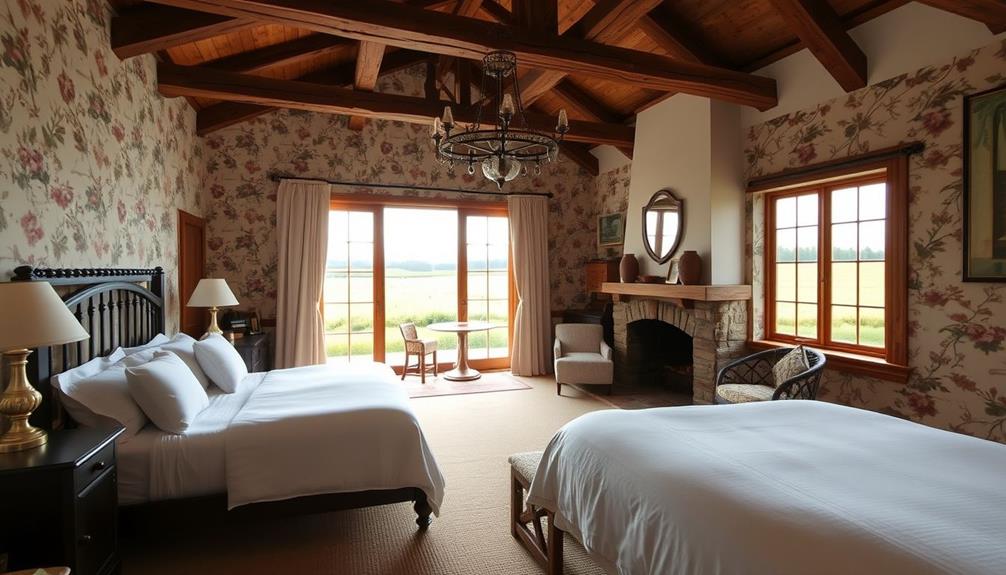
Step into the Elegant Farmhouse Suite, where rustic charm meets modern luxury. You'll immediately appreciate the shiplap walls and vintage-inspired furnishings that create a cozy yet sophisticated atmosphere.
The soft, muted color palette of whites, creams, and soft grays provides a tranquil backdrop, encouraging relaxation and comfort during your stay. As you explore, you'll notice carefully chosen decor elements like reclaimed wood accents and antique accessories that enhance the farmhouse aesthetic, infusing the space with unique character.
The luxurious bedding, featuring high-thread-count cotton sheets and plush comforters, promises a restful night's sleep, adding to the suite's elegant appeal. Large windows flood the room with natural light, beautifully connecting the interior to the picturesque surroundings of the retreat center.
This balance of modern amenities and rustic charm makes the Elegant Farmhouse Suite a perfect sanctuary for unwinding after a day of activities. Whether you're enjoying a quiet moment with a book or hosting an intimate gathering, this suite offers an inviting atmosphere that feels both homey and refined.
You'll leave feeling rejuvenated and inspired, ready to take on whatever comes next.
Frequently Asked Questions
How Can I Incorporate Local Culture Into Themed Rooms?
To incorporate local culture into themed rooms, you can use regional artwork, traditional textiles, and local crafts. Showcase stories or legends through decor, and feature local cuisine in your dining options to enhance the experience.
What Budget Should I Allocate for Each Themed Room?
You think budgeting's easy? Think again! For each themed room, allocate 10-20% of your total budget. This way, you won't end up with a lavish room that feels like a bargain bin disaster!
How Do I Choose the Right Furniture for Each Theme?
To choose the right furniture for your theme, consider the mood you want to create. Match colors, styles, and functionality to enhance the experience. Don't forget to prioritize comfort and durability for guests' satisfaction!
What Are Some Essential Accessories for Enhancing Themes?
Did you know that 70% of guests remember their experience based on decor? To enhance themes, you'll want to incorporate thematic art, lighting, textiles, and unique accessories that align with your chosen concept, creating memorable environments.
How Can I Ensure a Cohesive Design Throughout the Retreat Center?
To guarantee a cohesive design throughout your retreat center, choose a consistent color palette, select complementary materials, and incorporate similar decorative elements. Regularly assess each space to maintain harmony and align with your overall vision.
Conclusion
No matter which theme you choose for your retreat center, each room can be a doorway to a unique experience. Like a painter with a blank canvas, you have the power to create spaces that inspire, rejuvenate, and bring people together. By embracing these ideas, you'll not only enhance your retreat's atmosphere but also make lasting memories for your guests. So, what are you waiting for? Immerse yourself in your creativity and transform your retreat into a sanctuary of joy!
- About the Author
- Latest Posts
Introducing Ron, the home decor aficionado at ByRetreat, whose passion for creating beautiful and inviting spaces is at the heart of his work. With his deep knowledge of home decor and his innate sense of style, Ron brings a wealth of expertise and a keen eye for detail to the ByRetreat team.
Ron’s love for home decor goes beyond aesthetics; he understands that our surroundings play a significant role in our overall well-being and productivity. With this in mind, Ron is dedicated to transforming remote workspaces into havens of comfort, functionality, and beauty.
Retreat
The Business of Retreats: Marketing Strategies for Success
Master the art of retreat marketing with strategies that captivate your audience and elevate your brand—discover the secrets that will set you apart.
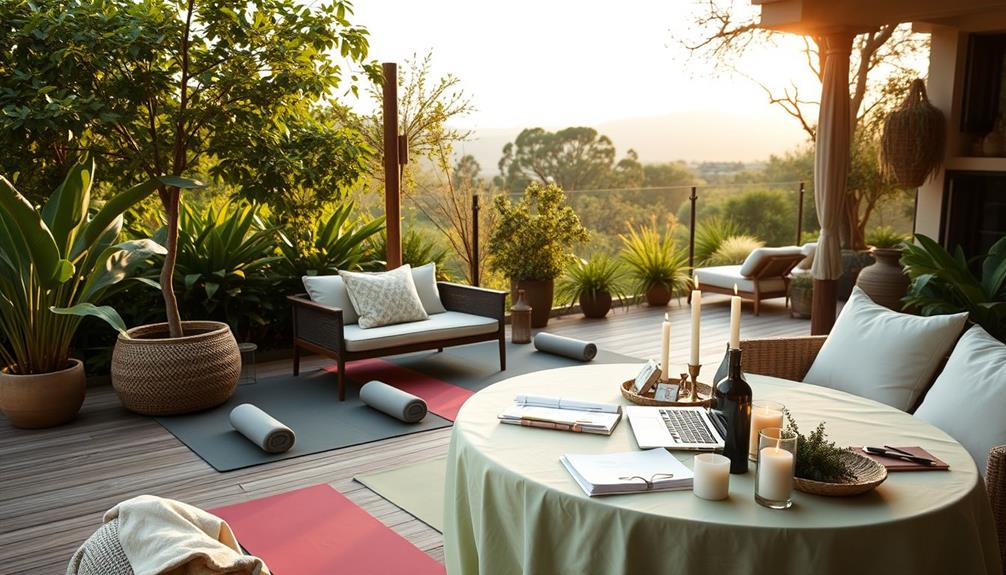
To succeed in the business of retreats, you need to start by understanding your audience. Conduct market research to create detailed buyer personas and identify their specific needs. Leverage social media to engage with users through compelling visuals and interactive content. Build a strong online presence with SEO optimization and participant testimonials that establish credibility. Craft marketing campaigns that highlight your unique selling proposition and adjust based on feedback. Finally, foster a community through local partnerships and wellness events. These strategies can greatly enhance your retreat's appeal and effectiveness, and there's more valuable insight ahead.
Key Takeaways
- Conduct thorough market research to understand demographics, preferences, and wellness trends tailored to your target audience.
- Develop a strong online presence through SEO optimization, engaging content, and showcasing participant testimonials to build credibility.
- Utilize social media strategies, including engaging visuals and community participation, to enhance visibility and foster emotional connections.
- Create compelling marketing campaigns with a unique selling proposition and leverage testimonials to establish trust and attract attendees.
- Foster partnerships with local businesses and influencers to enrich experiences and broaden reach through collaborative wellness events and exclusive offers.
Understanding Your Audience

Understanding your audience is the cornerstone of effective marketing for retreats. By identifying your target, you'll open up the potential for crafting tailored marketing messages that resonate deeply. Start with market research to gather insights about your audience's demographics and psychographics, such as age, income, and lifestyle preferences. This knowledge allows you to develop detailed buyer personas that represent your ideal attendees.
Additionally, embracing the benefits of curiosity can enhance your understanding of your audience, leading to more innovative and engaging marketing strategies.
Next, plunge into understanding their specific needs and desires. Utilize surveys and feedback mechanisms to gain deeper insights into audience preferences, which will help differentiate your marketing approaches. By prioritizing audience engagement, you can create an emotional connection with potential participants, making them feel understood and valued.
Additionally, keep an eye on trends in wellness that resonate with your target demographic. This awareness not only enhances your marketing strategies but also guarantees you're meeting the evolving interests of your audience.
Ultimately, by mastering the art of understanding your audience, you'll position your retreat for success, driving participation and fostering a loyal community that aligns with your mission.
Leveraging Social Media

Once you've grasped who your audience is, it's time to harness the power of social media to amplify your retreat's visibility. With over 3.6 billion users globally, platforms like Instagram and Facebook are essential for retreat marketing. Focus on creating engaging content that resonates with your target audience, such as live Q&A sessions or polls, which can boost interaction rates considerably.
Visual storytelling is another key element; high-quality images and videos of past retreats can foster emotional connections and enhance shares by 94%. Consistent posting and active participation in wellness-related communities can lead to a 67% increase in audience engagement, which helps build trust with potential attendees.
Here's a quick overview of effective strategies:
| Strategy | Benefit | Example |
|---|---|---|
| Engaging Content | Increases interaction | Live Q&A sessions |
| Visual Storytelling | Enhances emotional connection | High-quality videos |
| Consistent Posting | Boosts online visibility | Regular updates |
Building an Impactful Online Presence

Creating an impactful online presence is essential for attracting attendees to your retreat. To effectively market your unique experiences, consider these strategies:
1. Optimize for SEO: Use relevant keywords throughout your website to enhance visibility. This helps potential guests find your retreat easily, making your online presence more effective.
Incorporating uplifting themes, similar to those found in songs like Blue Skies and Lemonade, can further boost your appeal to guests seeking positivity.
2. Engage with Content Delivery: Regularly update your blog with informative posts about wellness and retreats. This not only establishes your authority but also keeps your audience engaged and informed.
Sharing insights on techniques for creating thematic coherence in your offerings can resonate with your audience and deepen their interest.
3. Showcase Participant Stories: Include testimonials and transformation experiences on your site. This builds credibility and creates an emotional connection, allowing potential guests to envision their own journey with you.
Additionally, offering virtual tours of your facilities can greatly enhance user engagement. Prospective attendees can explore the serene environment and services before making a booking decision.
By implementing these marketing strategies, you'll foster a loyal community around your retreat while making sure that your online presence resonates with those seeking tranquility and wellness.
Ultimately, these efforts will help you attract more attendees and guarantee the success of your retreat.
Crafting Compelling Marketing Campaigns
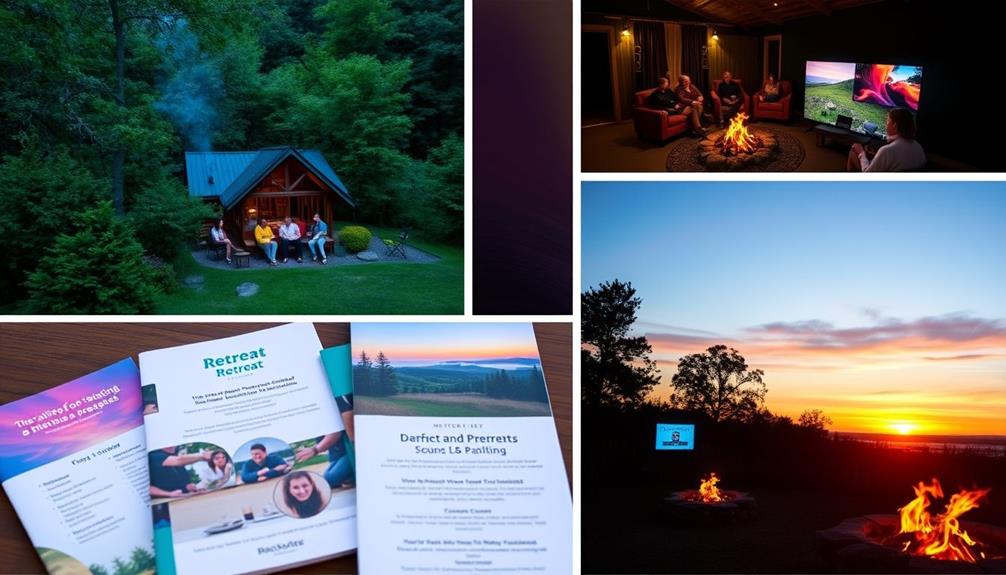
Effective marketing campaigns are essential for drawing attention to your retreat and enticing potential attendees. To craft compelling campaigns, start by developing a unique selling proposition (USP) that resonates with your target audience. This sets your retreat apart and attracts participants effectively. Utilize engaging visuals and narratives in your marketing materials to enhance audience engagement and spark interest.
Here's a quick overview of effective marketing strategies:
| Strategy | Description | Benefits |
|---|---|---|
| Social Media | Use platforms for targeted ads and organic posts | Broader reach and visibility |
| Engaging Content | Create educational, inspirational, and promotional materials | Fosters deeper connections with your audience |
| Leverage Testimonials | Share success stories from past attendees | Builds trust and credibility |
Don't forget to monitor and adjust your campaigns based on audience feedback and engagement metrics. This guarantees your marketing efforts remain relevant and effective. Collaborating with influencers can also amplify your message, reaching a wider audience. By focusing on these elements, you'll engage your audience and increase participation in your retreat.
Fostering Community and Partnerships

Regularly fostering community and partnerships can greatly enhance the overall experience of your retreat. When attendees feel connected, they're more likely to return and share their experiences, boosting attendee loyalty and word-of-mouth referrals.
To create a vibrant community, consider these strategies:
- Collaborate with local businesses and wellness brands: This not only broadens your marketing reach but also enriches the retreat experience. For instance, partnering with local artisans can provide unique decor elements that enhance the ambiance of your space, similar to how cultural decor can add depth to a retreat environment. Offer exclusive deals or services, making attendees feel valued and connected to the local community.
- Host wellness events or online forums: These activities help build relationships among attendees, extending the community beyond the retreat. This ongoing engagement fosters a sense of belonging and shared purpose.
- Engage in influencer collaborations: Partnering with aligned influencers can amplify your marketing efforts. Their authentic endorsements resonate with followers, generating increased interest and bookings for your retreats.
Frequently Asked Questions
How Do I Market My Retreat?
To market your retreat, craft personalized messages that resonate with potential attendees, share engaging content on social media, optimize your website for search engines, partner with influencers, and create urgency through special offers and discounts.
Are Retreats Profitable?
Yes, retreats can be profitable. You'll find profit margins between 20% and 50%, especially if you manage operational costs effectively, offer unique experiences, and implement strategies like early bird discounts to attract more participants.
How Do You Organize a Successful Retreat?
To organize a successful retreat, define your purpose and audience, choose a serene location, create a balanced schedule, promote effectively, and gather feedback afterward to improve future experiences. You'll enhance satisfaction and engagement.
How to Start a Spiritual Retreat Business?
To start a spiritual retreat business, identify your niche and research wellness trends. Create a solid business plan, craft a unique brand identity, and leverage social media and partnerships to attract your target audience effectively.
Conclusion
In the business of retreats, understanding your audience isn't just a theory; it's a game-changer. When you connect with participants on a personal level, you're not just filling spots—you're building a community. By leveraging social media and crafting targeted campaigns, you create lasting relationships that go beyond the retreat itself. Remember, it's not just about marketing; it's about creating experiences that resonate. So, dive deep, engage authentically, and watch your retreat flourish like never before.
- About the Author
- Latest Posts
Introducing Ron, the home decor aficionado at ByRetreat, whose passion for creating beautiful and inviting spaces is at the heart of his work. With his deep knowledge of home decor and his innate sense of style, Ron brings a wealth of expertise and a keen eye for detail to the ByRetreat team.
Ron’s love for home decor goes beyond aesthetics; he understands that our surroundings play a significant role in our overall well-being and productivity. With this in mind, Ron is dedicated to transforming remote workspaces into havens of comfort, functionality, and beauty.
Retreat
Creating a Meditation Room in Your Home: Tips and Ideas
Navigate your way to a tranquil meditation room at home with these essential tips, and discover how to transform your space into a serene sanctuary.
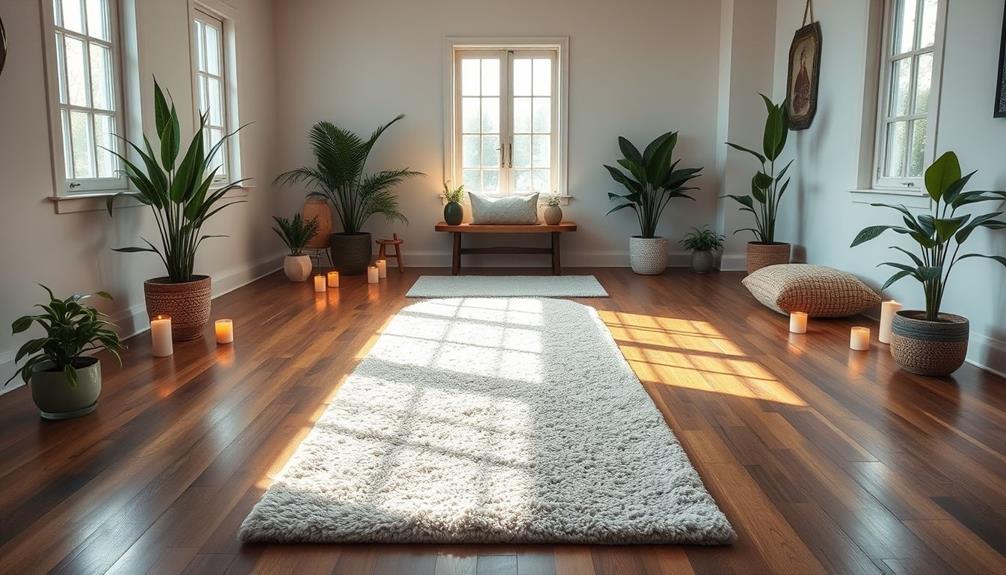
Creating a meditation room in your home can enhance your mindfulness practice. Start by choosing a quiet spot away from distractions. Embrace minimalism; declutter your space and use calming colors. Add personal touches like meaningful decor and cozy textiles to make it inviting. Maximize natural light with large windows and mirrors, and incorporate indoor plants to promote serenity. Enhance the ambiance with gentle nature sounds or a small fountain, and keep the space organized for ease and focus. Follow these guidelines, and you'll create a sanctuary that supports your meditation journey. There's much more to explore on this topic!
Key Takeaways
- Choose a quiet, serene location with natural light and a view of greenery to enhance relaxation during meditation.
- Embrace minimalism by decluttering the space and using calming colors to create a focused environment.
- Personalize the room with meaningful decor, cozy textiles, and soft fabrics to foster a comforting atmosphere.
- Incorporate nature elements like indoor plants and water features to enhance tranquility and connection to the outdoors.
- Enhance ambiance with soothing sounds, such as nature sounds or water fountains, while maintaining cleanliness and order in the space.
Choosing the Right Location

When it comes to creating your meditation room, selecting the right location is crucial for fostering a peaceful environment. Start by choosing a quiet location in your home, away from high-traffic areas. This way, you'll minimize distractions and interruptions during your meditation sessions.
A serene atmosphere is fundamental, and incorporating elements from nature can enhance your experience, much like the scenic views and natural beauty found in New England camping spots. Look for a space that offers plenty of natural light; positioning your meditation area near windows not only enhances your mood but also creates a calming atmosphere.
A view of nature can greatly improve your experience, so aim for a spot where you can see greenery or outdoor scenery. This connection to the outdoors promotes relaxation and mindfulness, making your practice more effective.
Additionally, verify the chosen area has enough space for comfortable movement. You'll want to stretch and change positions without feeling cramped, which is crucial for maintaining focus.
Embracing Minimalism
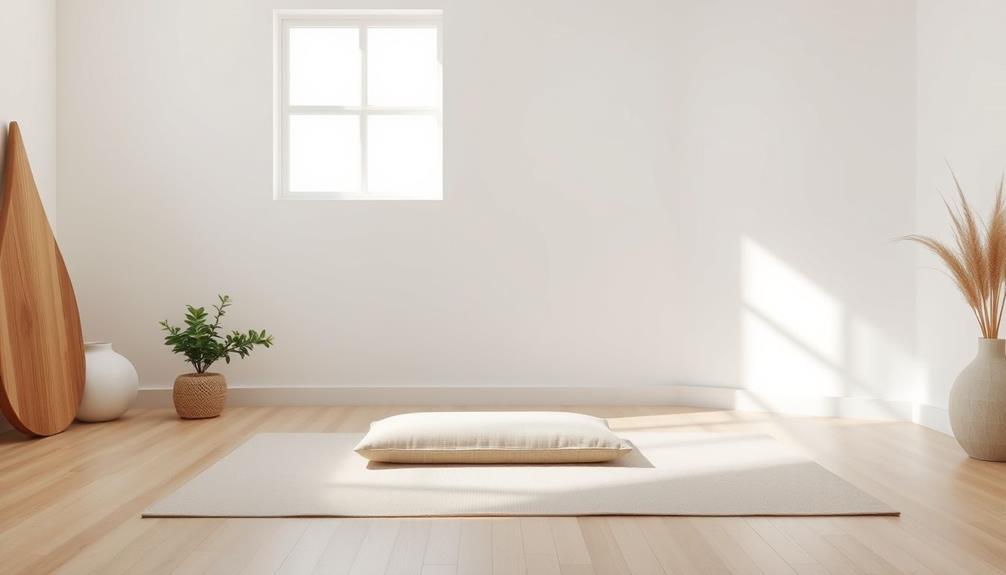
Embracing minimalism in your meditation room can greatly enhance your practice. By simplifying your decor and decluttering, you'll create a space that fosters focus and tranquility.
Prioritizing essential elements allows you to cultivate a calming atmosphere that supports mindfulness and intentional living. Incorporating elements like a simple coffee setup for mindful sipping can further enhance your relaxation, as coffee culture often emphasizes the importance of quality and experience unique offerings in coffee culture.
Simplify Your Decor
Creating a serene meditation room hinges on a minimalist approach that prioritizes simplicity and tranquility. To truly simplify your decor, focus on a clean and uncluttered design that enhances relaxation and reduces distractions. Embracing a balance between technology use and creative expression can also aid in establishing a peaceful atmosphere.
Start by incorporating calming colors like soft neutrals, which help create a relaxing environment free from overwhelming patterns. Limit your decor to essential items. A simple cushion for sitting and a small stool can maintain a no-frills yet stylish atmosphere.
This minimalist meditation room design allows you to concentrate on your practice without unnecessary visual noise. Adding a textured area rug can provide comfort without compromising the overall aesthetic, giving your feet a cozy spot during meditation.
To reinforce the purpose of the space, designate the area solely for meditation. This ownership fosters a deeper connection to the room, enhancing your overall experience.
Declutter for Focus
To achieve true focus in your meditation room, decluttering is essential. Embracing minimalism means removing excess belongings that can disrupt your peace. A distraction-free environment enhances your ability to clear your mind and immerse yourself in your practice, which can be particularly beneficial for individuals experiencing emotional dysregulation, as seen in conditions like Borderline Personality Disorder (BPD).
Start by keeping only the essential items in your space. This approach reduces visual noise, allowing for a more profound and uninterrupted meditation experience.
Consider minimalist decor, like simple cushions and a textured area rug, to create a chic yet calming atmosphere. These elements foster tranquility without overwhelming your senses.
Regularly assess your meditation room and remove items that no longer serve your purpose. This practice not only keeps your space tidy but also nurtures a habit of mindfulness.
As you declutter for focus, you'll find that a clean and uncluttered space promotes serenity and signals your mind to settle into the right headspace for meditation.
Prioritize Essential Elements
A meditation room thrives on vital elements that promote calm and focus. Embracing minimalism in your meditation space means reducing clutter and keeping only items that bring value. This fosters mindfulness and tranquility, important for deepening your practice.
Start by selecting a clean color palette with soft, neutral tones—these hues enhance relaxation and create a serene environment. Additionally, consider incorporating elements that support overall well-being, such as a small indoor plant, which can improve air quality and contribute to a peaceful atmosphere, as seen in natural remedies alongside conventional medications.
Choose multifunctional furniture to optimize your limited space. For instance, a meditation cushion can double as a reading seat or a spot for journaling, maintaining a minimalist aesthetic without sacrificing utility.
It's vital to reserve this area solely for meditation, ensuring it remains distraction-free. This practice not only supports your mental well-being but also reinforces the habit of mindfulness.
Regularly decluttering and organizing your meditation space keeps it inviting and invigorating. By prioritizing essential elements, you create an environment that nurtures both mental and physical health, making it easier to commit to your meditation routine.
Personal Touches and Comfort
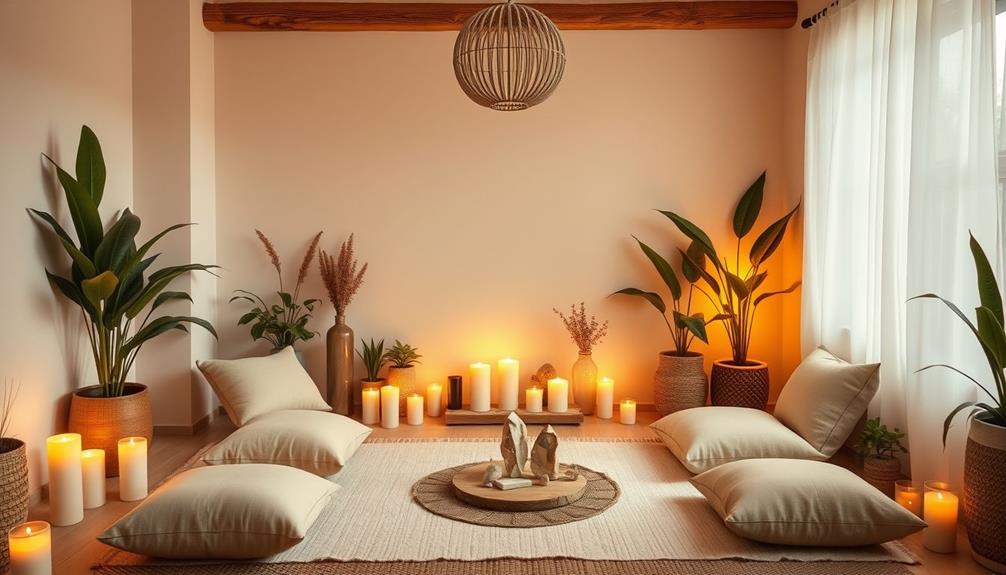
To make your meditation room truly yours, consider incorporating meaningful decor elements that resonate with you.
Choose cozy textiles in colors that calm your mind and enhance your comfort during sessions.
You might also want to explore the benefits of essential oils for relaxation, which can add a soothing aroma to your space.
Personalizing your space not only boosts your emotional connection but also enriches your overall meditation experience.
Meaningful Decor Elements
Creating a meditation room that truly reflects your personal journey involves infusing it with meaningful decor elements that resonate with your practice. By incorporating personal items, you not only enhance the ambiance but also foster a deeper connection to your space.
Think about what inspires you and choose decor that aligns with your meditation goals. For instance, you might find inspiration in heartfelt expressions of love that remind you of those who support your journey.
Here are some ideas to contemplate:
- Meaningful photographs of loved ones or special moments that evoke peace
- Crystals that bring positive energy, helping to ground your practice
- Inspirational quotes framed beautifully to motivate and uplift your spirit
- A vision board that visually represents your meditation goals and aspirations, serving as a constant reminder of your intentions
- Handmade pottery or unique artwork that reflects your individuality and adds character
These personal touches will create a comforting atmosphere, making your meditation sessions more enjoyable.
Cozy Textiles Selection
When selecting cozy textiles for your meditation room, focus on comfort and personal expression. Start with soft, breathable fabrics like cotton or linen for your cushions and throws. These materials enhance your comfort during meditation sessions, making your space more inviting.
Layer your textiles by adding a plush area rug and decorative pillows, which can be complemented by an atmosphere created by well-draining soil essential for preventing root rot. This creates a warm atmosphere that encourages relaxation and helps you unwind.
Opt for textiles in calming colors such as pastel hues or gentle earth tones to maintain a serene environment. These colors not only soothe the eye but also promote tranquility.
Consider incorporating weighted blankets or soft throws that provide a comforting sensation, enhancing your sense of security as you meditate.
Personalize your space further with handmade or unique textile pieces that resonate with your meditation journey. These special touches add individuality to your decor, making the room feel uniquely yours.
The right cozy textiles selection can transform your meditation room into a haven of peace and comfort, inviting you to return often for moments of reflection and relaxation.
Personalization Through Color
A harmonious color palette can truly transform your meditation room into a sanctuary of peace. By choosing soft tonal colors like warm whites, grays, and earthy tones, you can enhance relaxation and create a calming atmosphere. Incorporating calming colors such as blues and greens promotes tranquility while maintaining a cohesive scheme throughout the space.
This thoughtful approach to color selection echoes the importance of effective preparation in design, guaranteeing that your meditation room serves its intended purpose.
To personalize your meditation area, consider adding these elements:
- A soft sage green wall that invites relaxation
- Warm beige cushions that cradle you in comfort
- A pastel blue rug that feels soothing underfoot
- Meaningful artwork that resonates with your meditation goals
- Earth-toned decor items that reflect your personal meaning
These personal touches foster a sense of ownership and connection, enhancing overall comfort during meditation. By displaying meaningful objects, you not only elevate the ambiance but also create gentle reminders of your practice.
Experimenting with pastel hues can guarantee the space remains inviting and serene, making it ideal for deepening your meditation practice. Ultimately, your color choices will help establish a soothing environment, allowing you to fully immerse yourself in tranquility.
Color Choices for Relaxation
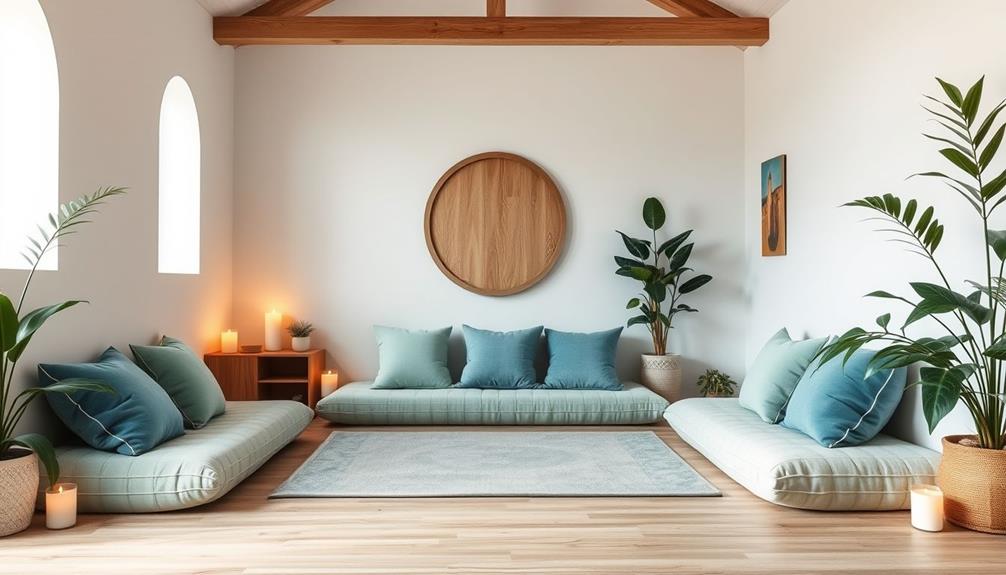
Choosing the right colors for your meditation room can greatly enhance your relaxation experience. Calming colors play an essential role in creating a serene environment, allowing you to focus and unwind. Soft tonal colors like warm whites, grays, and earthy tones are ideal for promoting tranquility. These shades help establish a peaceful atmosphere, making your meditation practices more effective.
To help you choose the best colors, consider the following options:
| Color | Effect |
|---|---|
| Soft White | Promotes clarity and spaciousness |
| Light Blue | Evokes calmness and serenity |
| Earthy Green | Connects to nature and grounding |
Avoid bright and energizing colors, as they can distract you from your goal of relaxation and mindfulness. Instead, aim for a cohesive color scheme throughout your meditation space to enhance the overall calming effect. Remember, your color choices for relaxation can greatly impact your mood, so select shades that evoke tranquility and peace. Create a sanctuary that invites you to pause and reflect, enriching your meditation journey.
Maximizing Natural Light
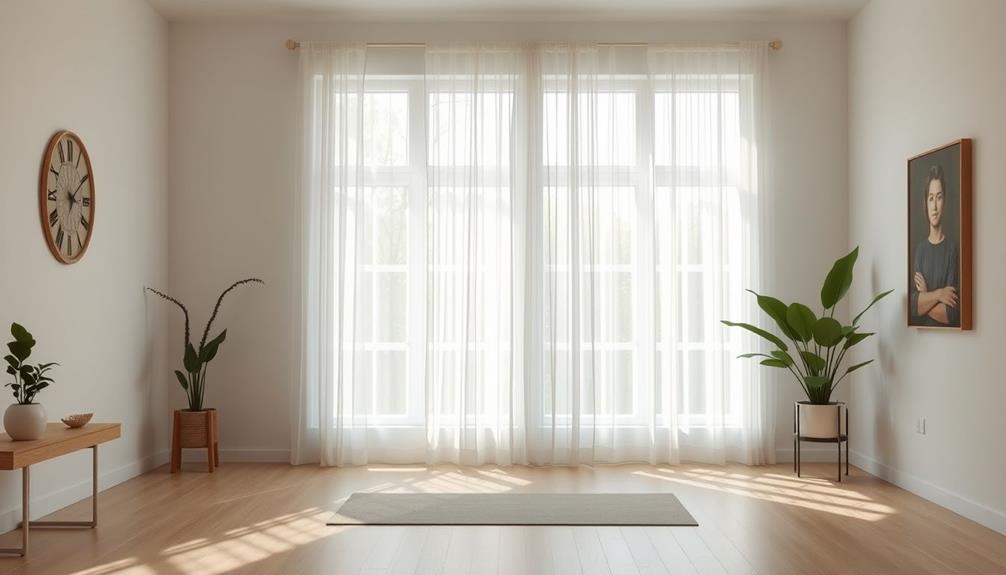
Natural light can transform your meditation room into a haven of peace and clarity. Position your meditation space near windows to take full advantage of the sunlight, which can uplift your mood and enhance relaxation.
Incorporating elements like natural materials can further enhance this calming environment, as seen in modern farmhouse decor trends. To create a serene atmosphere, use sheer curtains that diffuse sunlight while maintaining brightness.
Consider these tips to maximize natural light:
- Large windows that invite in ample sunlight
- Mirrors placed strategically to reflect light deeper into your space
- Light-colored decor and furnishings that amplify brightness
- Unobstructed views by keeping heavy furniture away from windows
- Soft, natural colors that evoke a sense of tranquility
Incorporating Textures
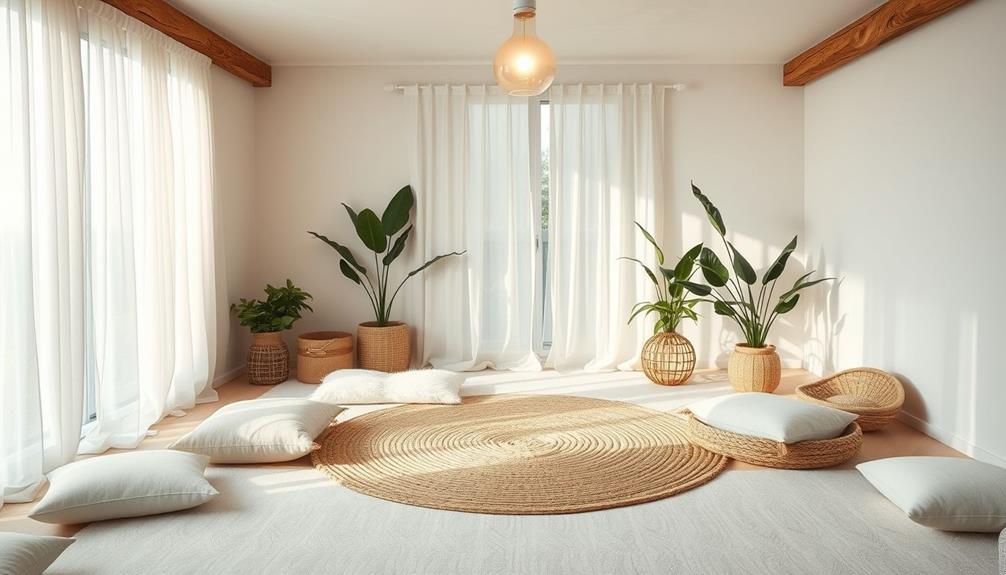
To create a truly calming meditation room, you'll want to focus on soft fabrics like cotton or linen that enhance comfort.
Layering textiles, such as plush rugs and cozy cushions, invites warmth and encourages relaxation.
Soft Fabrics Selection
Incorporating soft fabrics into your meditation room can greatly enhance comfort and create a soothing atmosphere. By selecting materials like cotton, linen, and bamboo, you can guarantee a calming atmosphere for your practice. These breathable fabrics promote airflow and regulate temperature, making your space inviting regardless of the season.
To elevate the sensory experience, consider adding the following elements:
- Plush rugs that cushion your feet and provide warmth
- Soft wall hangings that absorb sound and add texture
- Cozy throws to wrap yourself in during meditation
- Comfy cushions that invite you to sit and relax
- Sheer curtains that filter light and soften the room
Choosing soft fabrics in neutral colors can further enhance the tranquility of your meditation room. These hues create an inviting environment, allowing you to focus inward without distractions.
Layered Textiles Approach
Layering textiles in your meditation room can transform the space into a cozy sanctuary that enhances your practice. By incorporating a variety of soft fabrics—like plush blankets, cushions, and area rugs—you'll create an inviting atmosphere that promotes comfort.
Choose breathable materials such as cotton or linen for your cushions and throws to help regulate temperature, ensuring a pleasant environment during your meditation sessions.
Textured elements, like woven poufs and knitted throws, add visual interest while maintaining a calming ambiance. A soft rug over hardwood floors not only absorbs sound but also contributes to a quieter atmosphere, allowing you to focus more deeply on your meditation.
Utilizing multiple layers fosters a sense of warmth and grounding that's vital for a calming meditation experience. Combining different textures encourages deeper relaxation and mindfulness, enhancing your overall practice.
Creating a Functional Layout

A harmonious layout is essential for creating a meditation room that fosters tranquility and ease of use. When you design a layout, think about functionality and how each area will serve your needs. You want enough space for meditation and other activities without feeling cramped.
Consider incorporating the following elements:
- A cozy reading nook with soft lighting
- A dedicated journaling corner with a small desk
- Comfortable floor cushions spread around for flexibility
- Multi-functional furniture, like a storage ottoman for organization
- A clear pathway that encourages smooth changes between activities
Position your furniture to facilitate natural flow and accessibility. This way, you can easily shift from meditative practices to reading or journaling.
Using comfortable floor cushions or mats allows for movement and adaptability, especially in smaller spaces. By thoughtfully arranging your meditation space, you create an inviting atmosphere that encourages relaxation and mindfulness while enhancing the room's overall functionality.
Adding Nature Elements

Nature's presence can greatly enhance your meditation room, creating a calming sanctuary that invites peace and mindfulness. One effective way to bring nature into your meditation is by incorporating indoor plants. Choosing plants like peace lilies or snake plants not only improves air quality but also fosters a serene atmosphere.
You can also use nature-inspired colors—think earthy greens and browns—to enhance the calming effect of your space. These colors promote relaxation and help you connect more deeply with your surroundings during meditation.
Additionally, consider adding a water feature, such as a small fountain. The gentle sound of flowing water mimics nature and can deepen your meditative experience. It's a beautiful way to create a soothing backdrop that allows your mind to relax.
Positioning your meditation area near windows maximizes natural light, making the space bright and airy. If you have the option, creating an outdoor meditation space with comfortable seating and natural elements like stones and wood will further enhance your connection to nature, enriching your overall meditation experience.
Enhancing Ambiance With Sound
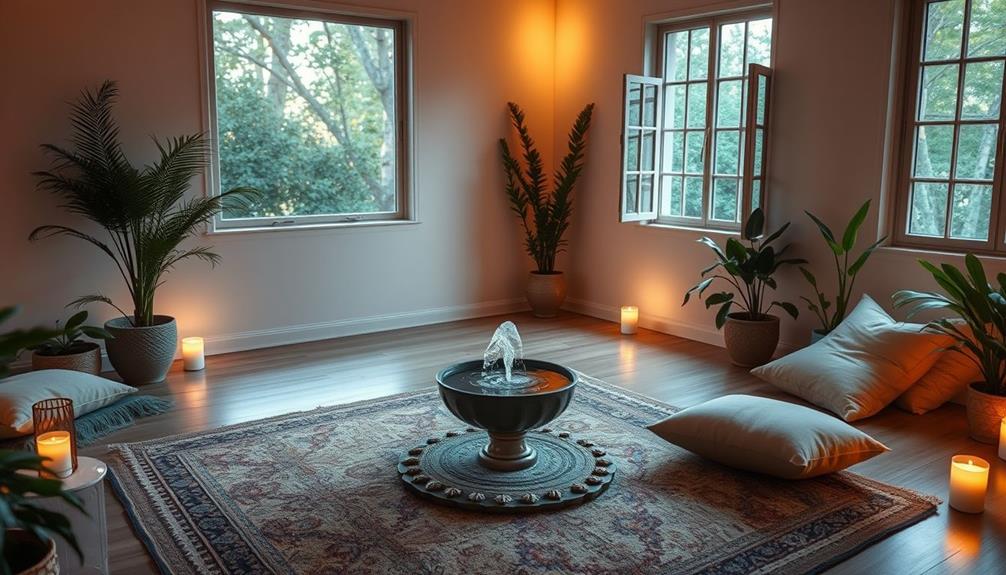
Creating a serene atmosphere in your meditation room isn't just about visual elements; sound plays an essential role too. Incorporating calming sound elements can greatly enhance your relaxation and deepen your meditative experience.
Consider these ideas to elevate the ambiance:
- Gentle nature sounds, like rustling leaves or chirping birds
- A small water fountain providing soothing background sounds
- Soft music playlists that promote mindfulness and focus
- Soundproofing techniques, such as thick rugs and curtains to block external noise
- Experimenting with sound frequencies through singing bowls or sound baths
Maintaining Cleanliness and Order

To maintain a truly peaceful meditation room, regular cleanliness and order are key components. Start with decluttering your space; a clean area helps you focus better and enhances mindfulness during your practice. Make it a habit to tidy up daily, ensuring that surfaces and textiles are kept clean. This routine not only creates an inviting atmosphere but also contributes to a more serene environment for meditation.
Organizing your items for easy access fosters functionality while instilling a sense of calm. Keep only what you need, minimizing distractions that could interrupt your meditation. Clean and fresh textiles, such as cushions and rugs, should be maintained regularly to promote hygiene and comfort. You'll find that a well-organized space allows you to settle into your practice more effortlessly.
Lastly, remember that a clutter-free meditation area enhances your overall experience. By committing to these practices, you'll cultivate a tranquil sanctuary that encourages deeper reflection and relaxation. Maintaining cleanliness and order will transform your meditation room into a true haven, making each session a rewarding escape from the chaos of daily life.
Frequently Asked Questions
How to Set up a Meditation Room in Your Home?
To set up a meditation room, find a quiet corner, use soft colors, and add calming decor. Incorporate comfortable seating and maximize natural light while personalizing with meaningful items to enhance your practice.
How to Make a Zen Room at Home?
Think of your home as a canvas; you can paint a Zen room filled with tranquility. Choose a serene corner, soften colors, add comfy seating, and let nature's touch create your perfect sanctuary for mindfulness.
What Color Should a Meditation Room Be?
Your meditation room should embrace soft tonal colors like warm whites, grays, or earthy tones. Blues and greens promote relaxation, while pastels create an inviting atmosphere. Avoid bright colors to maintain a tranquil environment.
How to Design a Meditation Center?
Designing a meditation center isn't rocket science; just toss some cushions and call it zen! Seriously, pick a quiet spot, add calming colors, comfy seating, and maybe some plants. Voila! Instant tranquility.
Conclusion
Creating a meditation room in your home can transform your space into a sanctuary of peace and relaxation. By thoughtfully selecting your location, embracing minimalism, and adding personal touches, you can craft an environment that resonates with tranquility. Isn't it time you took a break from the chaos and found your calm? With the right colors, natural elements, and soothing sounds, you'll not only enhance your meditation practice but also nurture your overall well-being.
- About the Author
- Latest Posts
Introducing Ron, the home decor aficionado at ByRetreat, whose passion for creating beautiful and inviting spaces is at the heart of his work. With his deep knowledge of home decor and his innate sense of style, Ron brings a wealth of expertise and a keen eye for detail to the ByRetreat team.
Ron’s love for home decor goes beyond aesthetics; he understands that our surroundings play a significant role in our overall well-being and productivity. With this in mind, Ron is dedicated to transforming remote workspaces into havens of comfort, functionality, and beauty.
-

 Retreat1 week ago
Retreat1 week agoDIY Aromatherapy Diffusers for a Spa-Like Atmosphere at Home
-

 Retreat2 weeks ago
Retreat2 weeks agoThe Profitability of Retreat Centers: A Financial Analysis
-

 Retreat1 week ago
Retreat1 week agoUnusual DIY Projects: Designing a Space Probe in Bitlife
-

 Retreat2 weeks ago
Retreat2 weeks agoComprehensive Review: Are Home Decorators Ceiling Fans Worth the Investment?
-

 Retreat2 weeks ago
Retreat2 weeks agoIs Opening a Home Decor Store Profitable in 2024?
-

 Retreat1 week ago
Retreat1 week agoHow to Create a Zen Garden for Your Retreat Center
-

 Retreat2 weeks ago
Retreat2 weeks agoStep-By-Step Tutorial: Reupholstering a Chair With Buttons
-

 Retreat5 days ago
Retreat5 days agoThe Psychology of Color in Retreat Center Design











